The Impact of Female Genital Mutilation on Women in the United Kingdom
VerifiedAdded on 2024/06/07
|34
|8311
|445
AI Summary
This research explores the experiences of female genital mutilation (FGM) on women in the United Kingdom. It examines the cultural and religious justifications for FGM, its short-term and long-term effects on women's physical and mental health, and the current state of FGM practices in Britain. The study utilizes both quantitative and qualitative data analysis, including surveys of healthcare workers and interviews with FGM survivors. The findings highlight the devastating consequences of FGM and emphasize the need for comprehensive interventions to protect women and girls from this harmful practice.
Contribute Materials
Your contribution can guide someone’s learning journey. Share your
documents today.
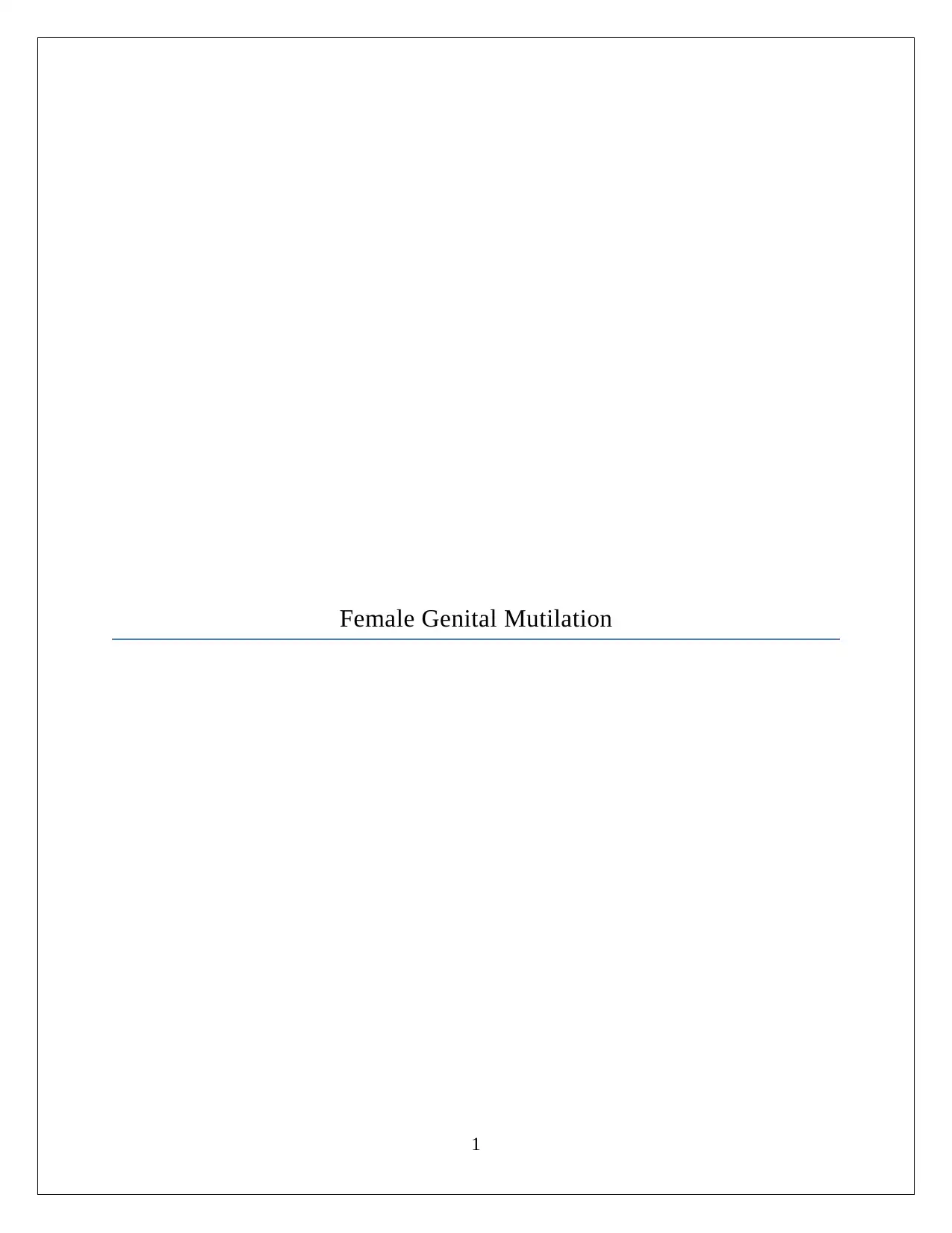
Female Genital Mutilation
1
1
Secure Best Marks with AI Grader
Need help grading? Try our AI Grader for instant feedback on your assignments.
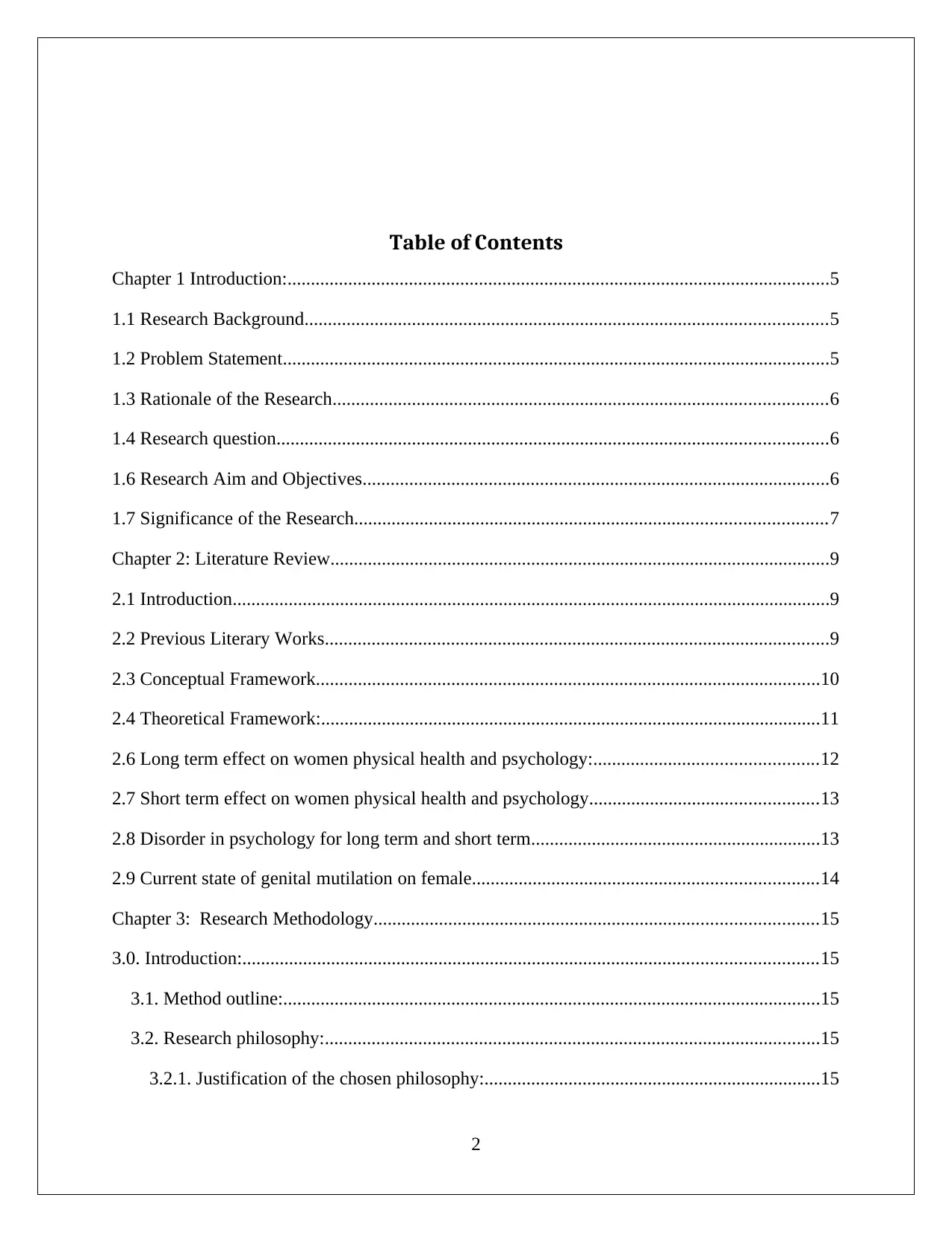
Table of Contents
Chapter 1 Introduction:....................................................................................................................5
1.1 Research Background................................................................................................................5
1.2 Problem Statement.....................................................................................................................5
1.3 Rationale of the Research..........................................................................................................6
1.4 Research question......................................................................................................................6
1.6 Research Aim and Objectives....................................................................................................6
1.7 Significance of the Research.....................................................................................................7
Chapter 2: Literature Review...........................................................................................................9
2.1 Introduction................................................................................................................................9
2.2 Previous Literary Works............................................................................................................9
2.3 Conceptual Framework............................................................................................................10
2.4 Theoretical Framework:...........................................................................................................11
2.6 Long term effect on women physical health and psychology:................................................12
2.7 Short term effect on women physical health and psychology.................................................13
2.8 Disorder in psychology for long term and short term..............................................................13
2.9 Current state of genital mutilation on female..........................................................................14
Chapter 3: Research Methodology...............................................................................................15
3.0. Introduction:...........................................................................................................................15
3.1. Method outline:...................................................................................................................15
3.2. Research philosophy:..........................................................................................................15
3.2.1. Justification of the chosen philosophy:........................................................................15
2
Chapter 1 Introduction:....................................................................................................................5
1.1 Research Background................................................................................................................5
1.2 Problem Statement.....................................................................................................................5
1.3 Rationale of the Research..........................................................................................................6
1.4 Research question......................................................................................................................6
1.6 Research Aim and Objectives....................................................................................................6
1.7 Significance of the Research.....................................................................................................7
Chapter 2: Literature Review...........................................................................................................9
2.1 Introduction................................................................................................................................9
2.2 Previous Literary Works............................................................................................................9
2.3 Conceptual Framework............................................................................................................10
2.4 Theoretical Framework:...........................................................................................................11
2.6 Long term effect on women physical health and psychology:................................................12
2.7 Short term effect on women physical health and psychology.................................................13
2.8 Disorder in psychology for long term and short term..............................................................13
2.9 Current state of genital mutilation on female..........................................................................14
Chapter 3: Research Methodology...............................................................................................15
3.0. Introduction:...........................................................................................................................15
3.1. Method outline:...................................................................................................................15
3.2. Research philosophy:..........................................................................................................15
3.2.1. Justification of the chosen philosophy:........................................................................15
2
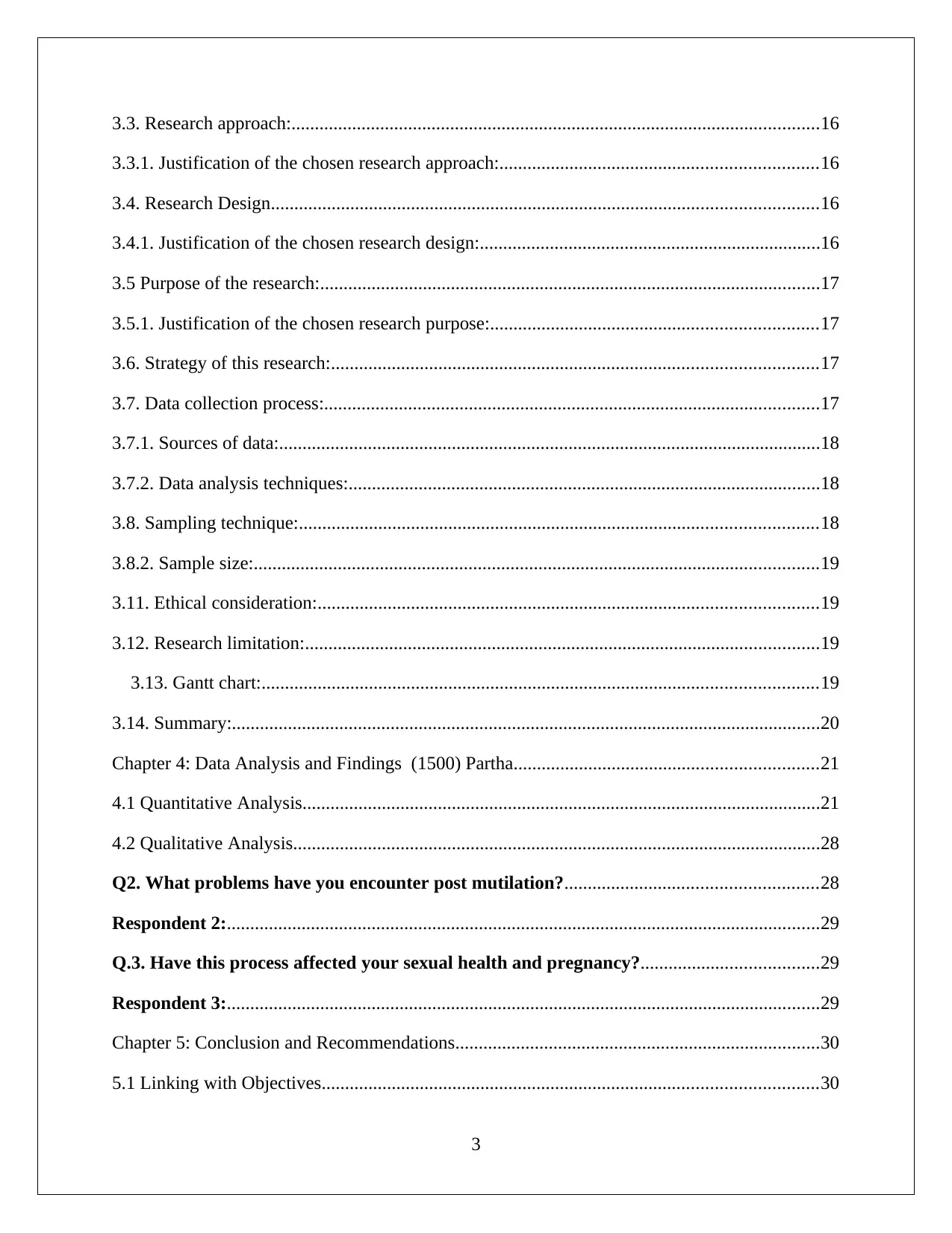
3.3. Research approach:.................................................................................................................16
3.3.1. Justification of the chosen research approach:....................................................................16
3.4. Research Design.....................................................................................................................16
3.4.1. Justification of the chosen research design:.........................................................................16
3.5 Purpose of the research:...........................................................................................................17
3.5.1. Justification of the chosen research purpose:......................................................................17
3.6. Strategy of this research:........................................................................................................17
3.7. Data collection process:..........................................................................................................17
3.7.1. Sources of data:....................................................................................................................18
3.7.2. Data analysis techniques:.....................................................................................................18
3.8. Sampling technique:...............................................................................................................18
3.8.2. Sample size:.........................................................................................................................19
3.11. Ethical consideration:...........................................................................................................19
3.12. Research limitation:..............................................................................................................19
3.13. Gantt chart:.......................................................................................................................19
3.14. Summary:..............................................................................................................................20
Chapter 4: Data Analysis and Findings (1500) Partha.................................................................21
4.1 Quantitative Analysis...............................................................................................................21
4.2 Qualitative Analysis.................................................................................................................28
Q2. What problems have you encounter post mutilation?......................................................28
Respondent 2:...............................................................................................................................29
Q.3. Have this process affected your sexual health and pregnancy?......................................29
Respondent 3:...............................................................................................................................29
Chapter 5: Conclusion and Recommendations..............................................................................30
5.1 Linking with Objectives..........................................................................................................30
3
3.3.1. Justification of the chosen research approach:....................................................................16
3.4. Research Design.....................................................................................................................16
3.4.1. Justification of the chosen research design:.........................................................................16
3.5 Purpose of the research:...........................................................................................................17
3.5.1. Justification of the chosen research purpose:......................................................................17
3.6. Strategy of this research:........................................................................................................17
3.7. Data collection process:..........................................................................................................17
3.7.1. Sources of data:....................................................................................................................18
3.7.2. Data analysis techniques:.....................................................................................................18
3.8. Sampling technique:...............................................................................................................18
3.8.2. Sample size:.........................................................................................................................19
3.11. Ethical consideration:...........................................................................................................19
3.12. Research limitation:..............................................................................................................19
3.13. Gantt chart:.......................................................................................................................19
3.14. Summary:..............................................................................................................................20
Chapter 4: Data Analysis and Findings (1500) Partha.................................................................21
4.1 Quantitative Analysis...............................................................................................................21
4.2 Qualitative Analysis.................................................................................................................28
Q2. What problems have you encounter post mutilation?......................................................28
Respondent 2:...............................................................................................................................29
Q.3. Have this process affected your sexual health and pregnancy?......................................29
Respondent 3:...............................................................................................................................29
Chapter 5: Conclusion and Recommendations..............................................................................30
5.1 Linking with Objectives..........................................................................................................30
3

5.2 Recommendations....................................................................................................................30
5.3 Future Scope of the Research..................................................................................................31
5.4 Conclusion...............................................................................................................................31
Reference List:...............................................................................................................................32
4
5.3 Future Scope of the Research..................................................................................................31
5.4 Conclusion...............................................................................................................................31
Reference List:...............................................................................................................................32
4
Secure Best Marks with AI Grader
Need help grading? Try our AI Grader for instant feedback on your assignments.
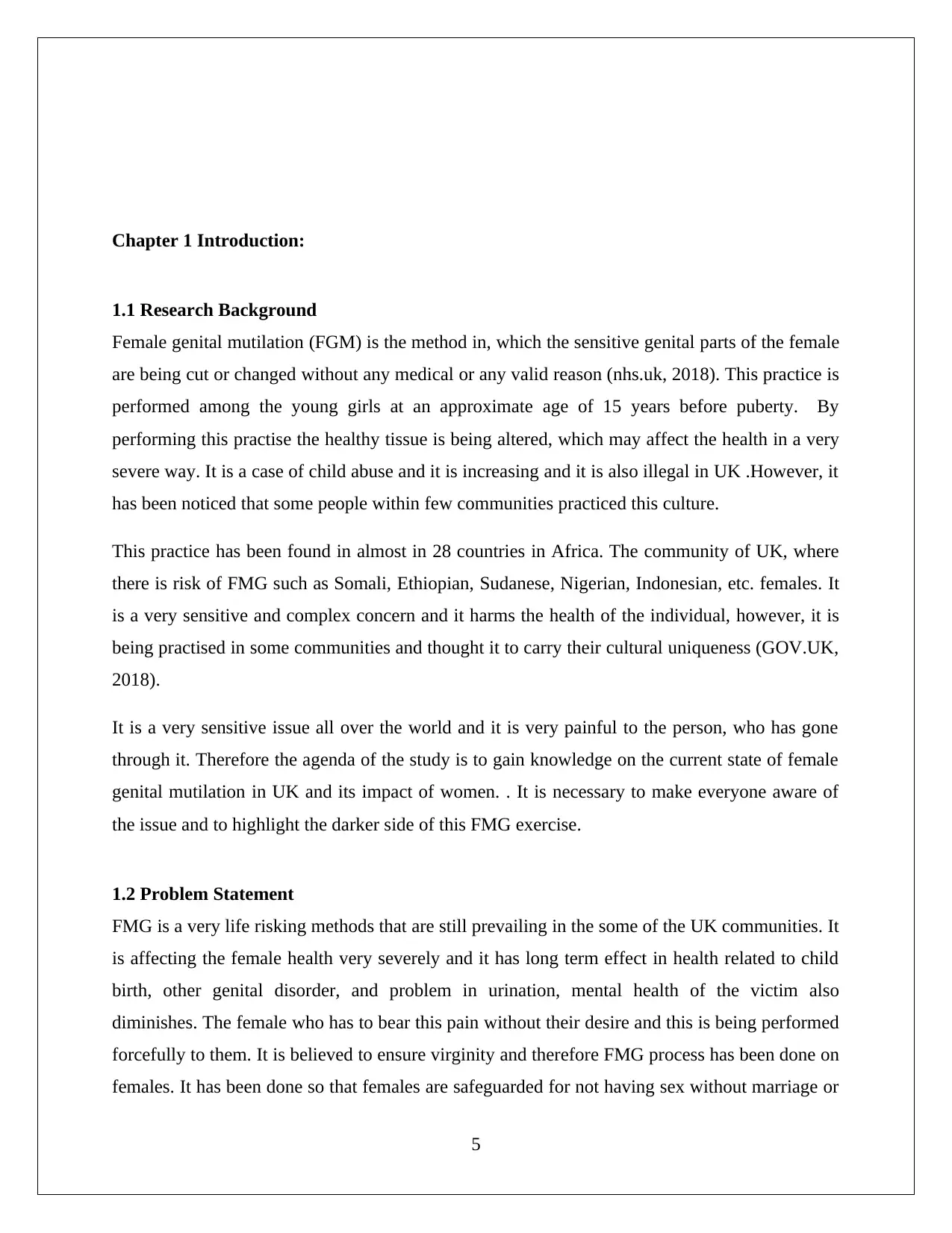
Chapter 1 Introduction:
1.1 Research Background
Female genital mutilation (FGM) is the method in, which the sensitive genital parts of the female
are being cut or changed without any medical or any valid reason (nhs.uk, 2018). This practice is
performed among the young girls at an approximate age of 15 years before puberty. By
performing this practise the healthy tissue is being altered, which may affect the health in a very
severe way. It is a case of child abuse and it is increasing and it is also illegal in UK .However, it
has been noticed that some people within few communities practiced this culture.
This practice has been found in almost in 28 countries in Africa. The community of UK, where
there is risk of FMG such as Somali, Ethiopian, Sudanese, Nigerian, Indonesian, etc. females. It
is a very sensitive and complex concern and it harms the health of the individual, however, it is
being practised in some communities and thought it to carry their cultural uniqueness (GOV.UK,
2018).
It is a very sensitive issue all over the world and it is very painful to the person, who has gone
through it. Therefore the agenda of the study is to gain knowledge on the current state of female
genital mutilation in UK and its impact of women. . It is necessary to make everyone aware of
the issue and to highlight the darker side of this FMG exercise.
1.2 Problem Statement
FMG is a very life risking methods that are still prevailing in the some of the UK communities. It
is affecting the female health very severely and it has long term effect in health related to child
birth, other genital disorder, and problem in urination, mental health of the victim also
diminishes. The female who has to bear this pain without their desire and this is being performed
forcefully to them. It is believed to ensure virginity and therefore FMG process has been done on
females. It has been done so that females are safeguarded for not having sex without marriage or
5
1.1 Research Background
Female genital mutilation (FGM) is the method in, which the sensitive genital parts of the female
are being cut or changed without any medical or any valid reason (nhs.uk, 2018). This practice is
performed among the young girls at an approximate age of 15 years before puberty. By
performing this practise the healthy tissue is being altered, which may affect the health in a very
severe way. It is a case of child abuse and it is increasing and it is also illegal in UK .However, it
has been noticed that some people within few communities practiced this culture.
This practice has been found in almost in 28 countries in Africa. The community of UK, where
there is risk of FMG such as Somali, Ethiopian, Sudanese, Nigerian, Indonesian, etc. females. It
is a very sensitive and complex concern and it harms the health of the individual, however, it is
being practised in some communities and thought it to carry their cultural uniqueness (GOV.UK,
2018).
It is a very sensitive issue all over the world and it is very painful to the person, who has gone
through it. Therefore the agenda of the study is to gain knowledge on the current state of female
genital mutilation in UK and its impact of women. . It is necessary to make everyone aware of
the issue and to highlight the darker side of this FMG exercise.
1.2 Problem Statement
FMG is a very life risking methods that are still prevailing in the some of the UK communities. It
is affecting the female health very severely and it has long term effect in health related to child
birth, other genital disorder, and problem in urination, mental health of the victim also
diminishes. The female who has to bear this pain without their desire and this is being performed
forcefully to them. It is believed to ensure virginity and therefore FMG process has been done on
females. It has been done so that females are safeguarded for not having sex without marriage or
5

not to feel the sexual pleasure before marriage (GOV.UK. (2018). It is also practiced to carry out
the religious belief in some communities. However, it is not at all supported by any religion. The
main problem of the research is to gain insights on the experiences of the women on genital
mutilation. . It is necessary to protect the girls and the female form FMG.
1.3 Rationale of the Research
The main concern of the topic is the practice of FMG among the female and the girls of around
15 years of age in UK. The process includes the cutting of female genital parts without any
specific reason and there is also no proper medical reason for this procedure. It is being practiced
in some communities of UK. It is being performed by four ways or it FMG has four parts such as
clitoridectomy it is a method of removing clitoris , excision it is a process of removing inner
parts of labia or all parts of clitoris , infibulations is a process of narrowing the opening of
vagina and other procedures also includes piercing, burning that specific area (nhs.uk, 2018).
There is no health benefit and it the method for controlling sexuality in female. It has been
observed all over the world and 200 million females have gone through this exercise.
It is a very sensitive issue as it affects the health of the female and the girls. It may result in
health related issue like, problem in giving birth to a child, urination problems; mental health of
the victim also deteriorates (England, 2018). It is necessary to protect the female form this
inhuman exercise of FMG.
Various data, statistics and information of FMG in UK has helped to understand the core
problem involved in it. It has helped to provide proper way to spread awareness about FMG in
the society. It reduces the exercise of FMG and one can easily find the information in this
project, which will help know about the current situation about the issue.
1.4 Research question
What are the experiences of female genital mutilation practices on women in United Kingdom?
1.6 Research Aim and Objectives
The purpose of the research is to gather knowledge on the experiences of female on genital
mutilation and analyze its short term and long effect on women.
6
the religious belief in some communities. However, it is not at all supported by any religion. The
main problem of the research is to gain insights on the experiences of the women on genital
mutilation. . It is necessary to protect the girls and the female form FMG.
1.3 Rationale of the Research
The main concern of the topic is the practice of FMG among the female and the girls of around
15 years of age in UK. The process includes the cutting of female genital parts without any
specific reason and there is also no proper medical reason for this procedure. It is being practiced
in some communities of UK. It is being performed by four ways or it FMG has four parts such as
clitoridectomy it is a method of removing clitoris , excision it is a process of removing inner
parts of labia or all parts of clitoris , infibulations is a process of narrowing the opening of
vagina and other procedures also includes piercing, burning that specific area (nhs.uk, 2018).
There is no health benefit and it the method for controlling sexuality in female. It has been
observed all over the world and 200 million females have gone through this exercise.
It is a very sensitive issue as it affects the health of the female and the girls. It may result in
health related issue like, problem in giving birth to a child, urination problems; mental health of
the victim also deteriorates (England, 2018). It is necessary to protect the female form this
inhuman exercise of FMG.
Various data, statistics and information of FMG in UK has helped to understand the core
problem involved in it. It has helped to provide proper way to spread awareness about FMG in
the society. It reduces the exercise of FMG and one can easily find the information in this
project, which will help know about the current situation about the issue.
1.4 Research question
What are the experiences of female genital mutilation practices on women in United Kingdom?
1.6 Research Aim and Objectives
The purpose of the research is to gather knowledge on the experiences of female on genital
mutilation and analyze its short term and long effect on women.
6
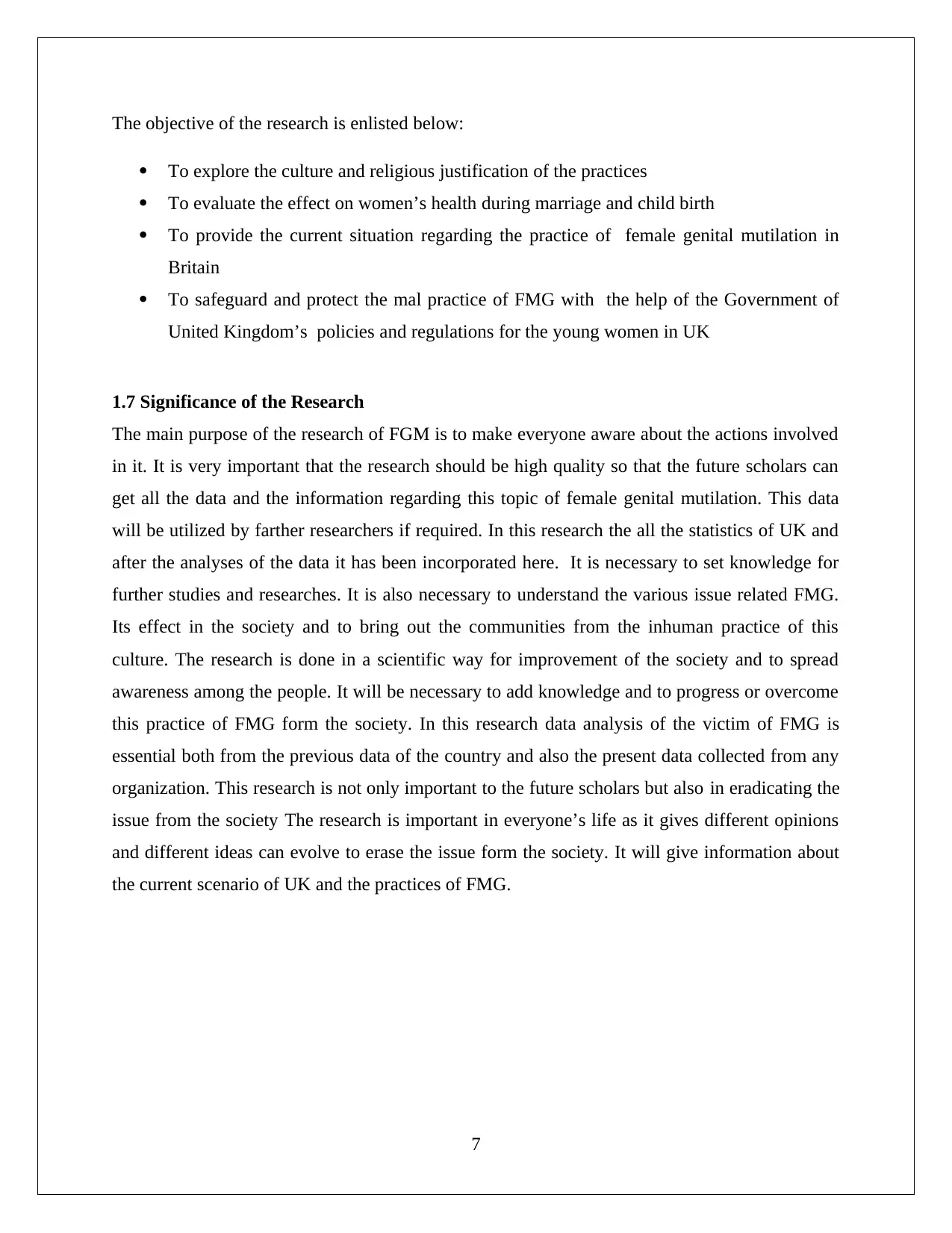
The objective of the research is enlisted below:
To explore the culture and religious justification of the practices
To evaluate the effect on women’s health during marriage and child birth
To provide the current situation regarding the practice of female genital mutilation in
Britain
To safeguard and protect the mal practice of FMG with the help of the Government of
United Kingdom’s policies and regulations for the young women in UK
1.7 Significance of the Research
The main purpose of the research of FGM is to make everyone aware about the actions involved
in it. It is very important that the research should be high quality so that the future scholars can
get all the data and the information regarding this topic of female genital mutilation. This data
will be utilized by farther researchers if required. In this research the all the statistics of UK and
after the analyses of the data it has been incorporated here. It is necessary to set knowledge for
further studies and researches. It is also necessary to understand the various issue related FMG.
Its effect in the society and to bring out the communities from the inhuman practice of this
culture. The research is done in a scientific way for improvement of the society and to spread
awareness among the people. It will be necessary to add knowledge and to progress or overcome
this practice of FMG form the society. In this research data analysis of the victim of FMG is
essential both from the previous data of the country and also the present data collected from any
organization. This research is not only important to the future scholars but also in eradicating the
issue from the society The research is important in everyone’s life as it gives different opinions
and different ideas can evolve to erase the issue form the society. It will give information about
the current scenario of UK and the practices of FMG.
7
To explore the culture and religious justification of the practices
To evaluate the effect on women’s health during marriage and child birth
To provide the current situation regarding the practice of female genital mutilation in
Britain
To safeguard and protect the mal practice of FMG with the help of the Government of
United Kingdom’s policies and regulations for the young women in UK
1.7 Significance of the Research
The main purpose of the research of FGM is to make everyone aware about the actions involved
in it. It is very important that the research should be high quality so that the future scholars can
get all the data and the information regarding this topic of female genital mutilation. This data
will be utilized by farther researchers if required. In this research the all the statistics of UK and
after the analyses of the data it has been incorporated here. It is necessary to set knowledge for
further studies and researches. It is also necessary to understand the various issue related FMG.
Its effect in the society and to bring out the communities from the inhuman practice of this
culture. The research is done in a scientific way for improvement of the society and to spread
awareness among the people. It will be necessary to add knowledge and to progress or overcome
this practice of FMG form the society. In this research data analysis of the victim of FMG is
essential both from the previous data of the country and also the present data collected from any
organization. This research is not only important to the future scholars but also in eradicating the
issue from the society The research is important in everyone’s life as it gives different opinions
and different ideas can evolve to erase the issue form the society. It will give information about
the current scenario of UK and the practices of FMG.
7
Paraphrase This Document
Need a fresh take? Get an instant paraphrase of this document with our AI Paraphraser
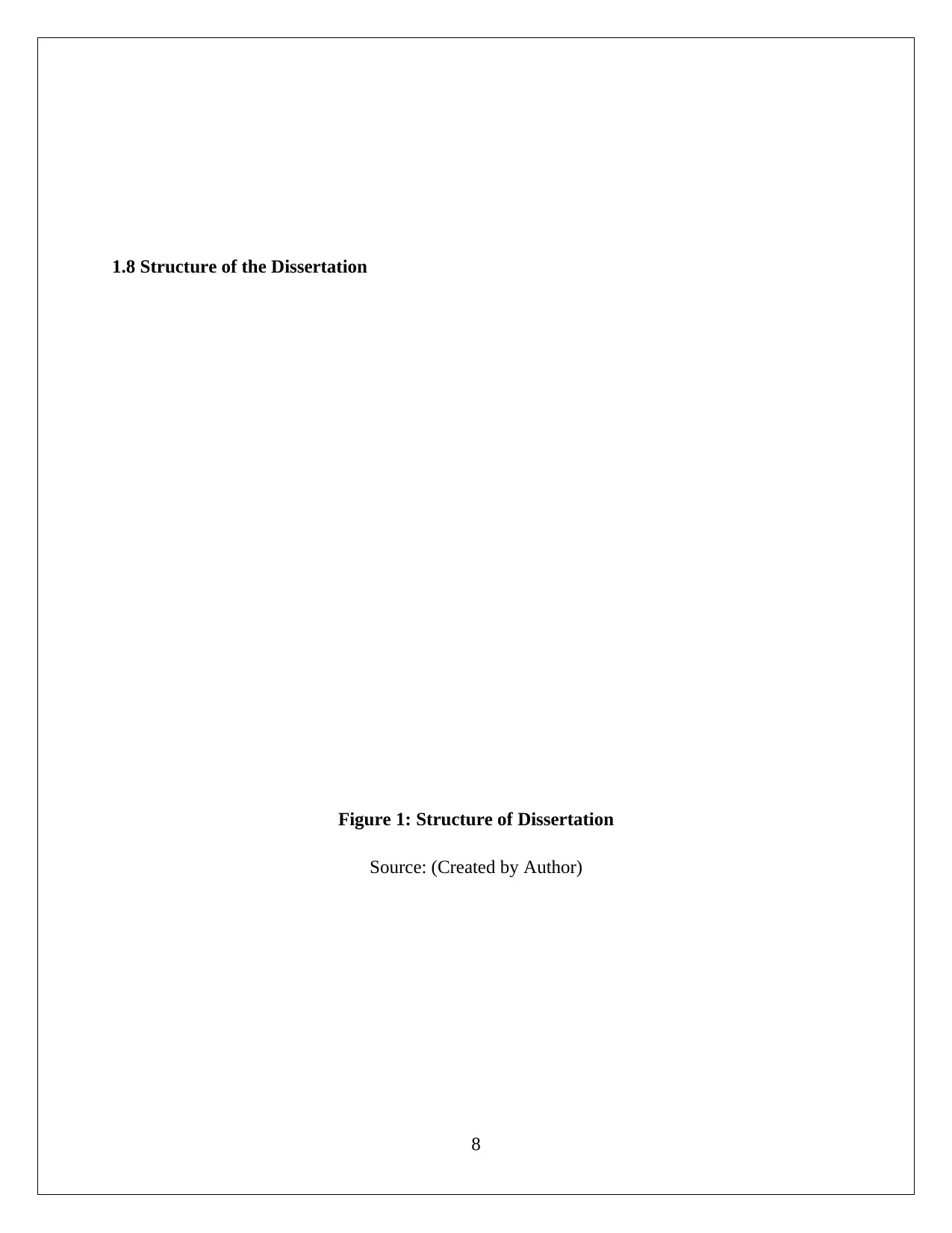
1.8 Structure of the Dissertation
Figure 1: Structure of Dissertation
Source: (Created by Author)
8
Figure 1: Structure of Dissertation
Source: (Created by Author)
8
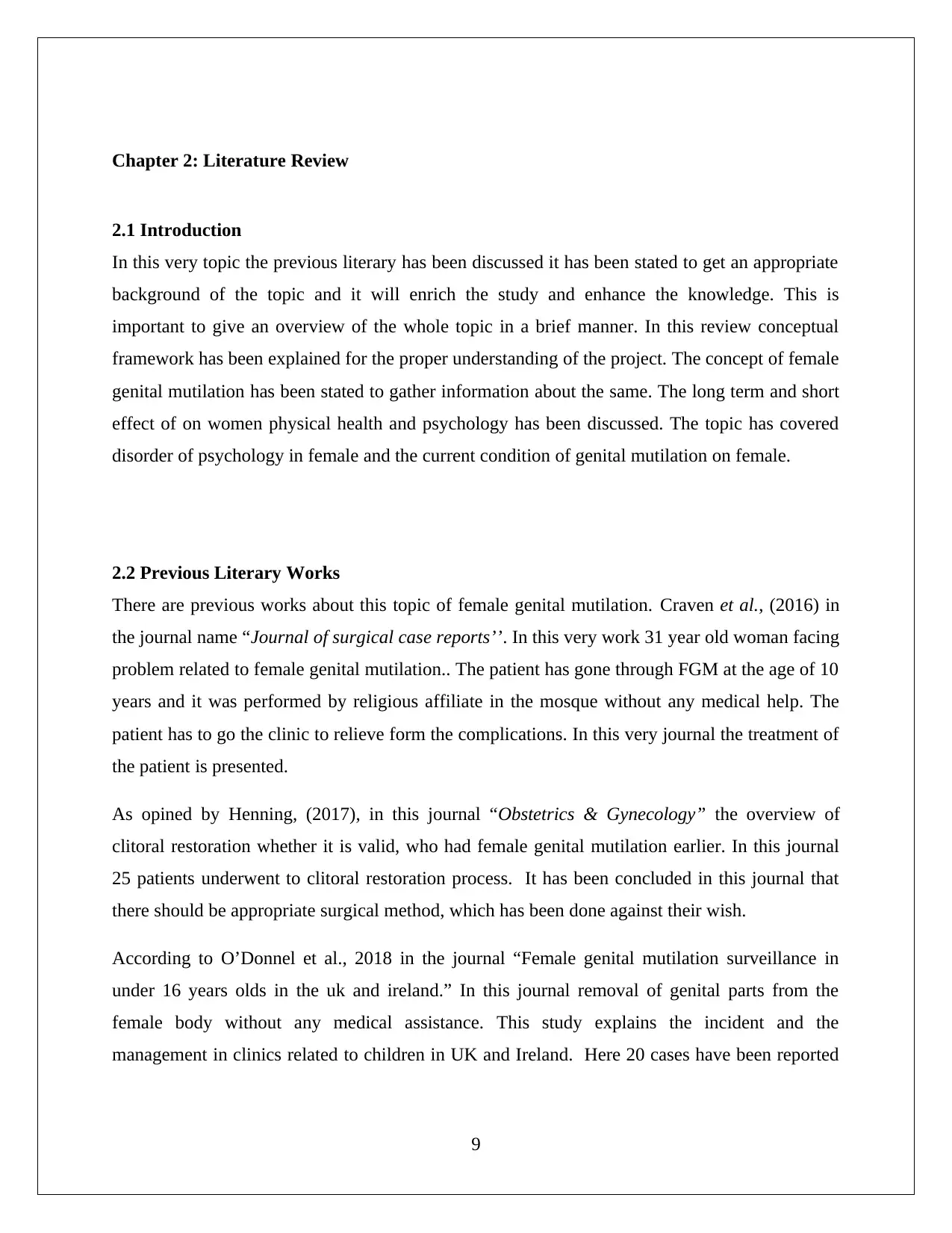
Chapter 2: Literature Review
2.1 Introduction
In this very topic the previous literary has been discussed it has been stated to get an appropriate
background of the topic and it will enrich the study and enhance the knowledge. This is
important to give an overview of the whole topic in a brief manner. In this review conceptual
framework has been explained for the proper understanding of the project. The concept of female
genital mutilation has been stated to gather information about the same. The long term and short
effect of on women physical health and psychology has been discussed. The topic has covered
disorder of psychology in female and the current condition of genital mutilation on female.
2.2 Previous Literary Works
There are previous works about this topic of female genital mutilation. Craven et al., (2016) in
the journal name “Journal of surgical case reports’’. In this very work 31 year old woman facing
problem related to female genital mutilation.. The patient has gone through FGM at the age of 10
years and it was performed by religious affiliate in the mosque without any medical help. The
patient has to go the clinic to relieve form the complications. In this very journal the treatment of
the patient is presented.
As opined by Henning, (2017), in this journal “Obstetrics & Gynecology” the overview of
clitoral restoration whether it is valid, who had female genital mutilation earlier. In this journal
25 patients underwent to clitoral restoration process. It has been concluded in this journal that
there should be appropriate surgical method, which has been done against their wish.
According to O’Donnel et al., 2018 in the journal “Female genital mutilation surveillance in
under 16 years olds in the uk and ireland.” In this journal removal of genital parts from the
female body without any medical assistance. This study explains the incident and the
management in clinics related to children in UK and Ireland. Here 20 cases have been reported
9
2.1 Introduction
In this very topic the previous literary has been discussed it has been stated to get an appropriate
background of the topic and it will enrich the study and enhance the knowledge. This is
important to give an overview of the whole topic in a brief manner. In this review conceptual
framework has been explained for the proper understanding of the project. The concept of female
genital mutilation has been stated to gather information about the same. The long term and short
effect of on women physical health and psychology has been discussed. The topic has covered
disorder of psychology in female and the current condition of genital mutilation on female.
2.2 Previous Literary Works
There are previous works about this topic of female genital mutilation. Craven et al., (2016) in
the journal name “Journal of surgical case reports’’. In this very work 31 year old woman facing
problem related to female genital mutilation.. The patient has gone through FGM at the age of 10
years and it was performed by religious affiliate in the mosque without any medical help. The
patient has to go the clinic to relieve form the complications. In this very journal the treatment of
the patient is presented.
As opined by Henning, (2017), in this journal “Obstetrics & Gynecology” the overview of
clitoral restoration whether it is valid, who had female genital mutilation earlier. In this journal
25 patients underwent to clitoral restoration process. It has been concluded in this journal that
there should be appropriate surgical method, which has been done against their wish.
According to O’Donnel et al., 2018 in the journal “Female genital mutilation surveillance in
under 16 years olds in the uk and ireland.” In this journal removal of genital parts from the
female body without any medical assistance. This study explains the incident and the
management in clinics related to children in UK and Ireland. Here 20 cases have been reported
9
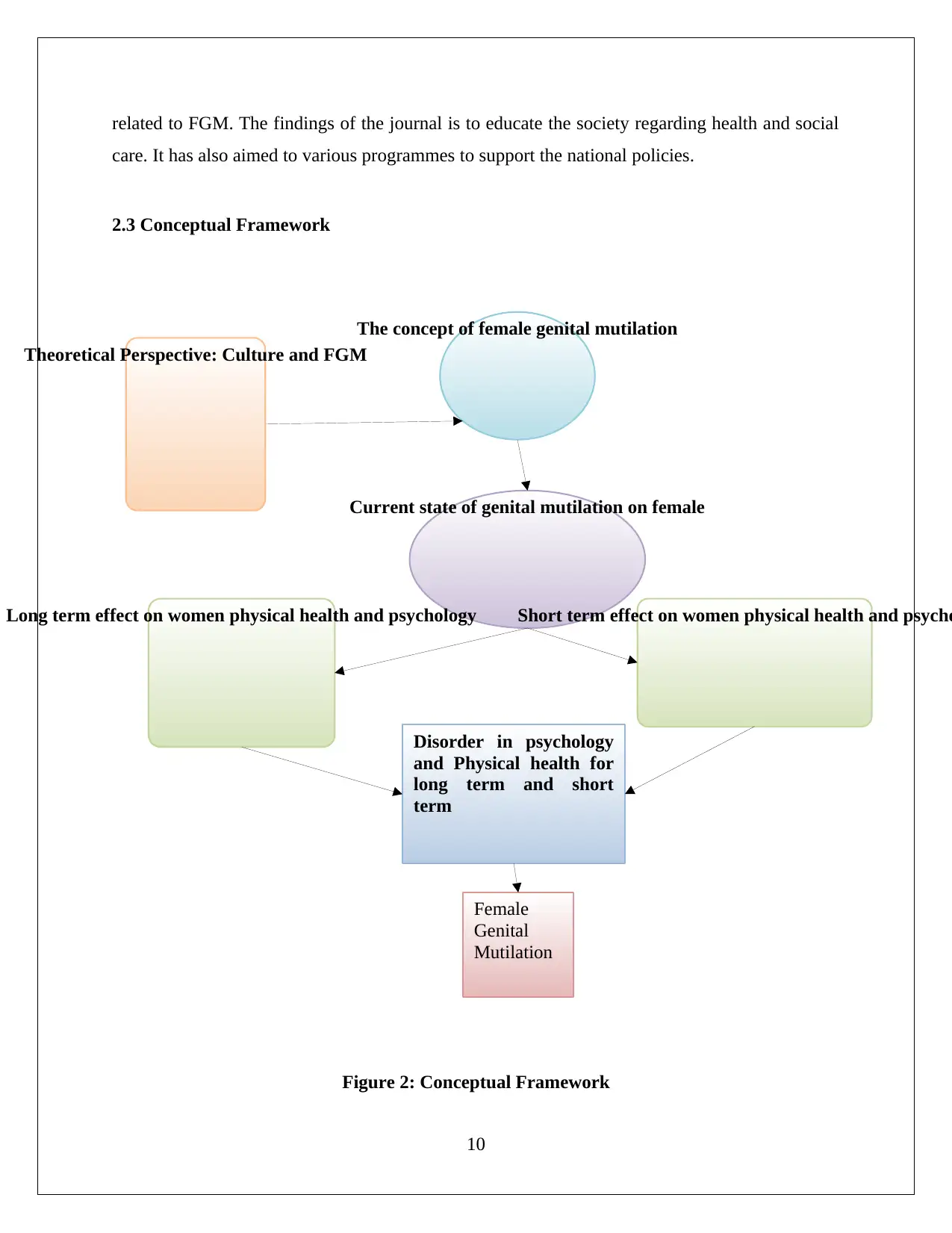
Female
Genital
Mutilation
Current state of genital mutilation on female
Short term effect on women physical health and psycho
The concept of female genital mutilation
Disorder in psychology
and Physical health for
long term and short
term
Theoretical Perspective: Culture and FGM
Long term effect on women physical health and psychology
related to FGM. The findings of the journal is to educate the society regarding health and social
care. It has also aimed to various programmes to support the national policies.
2.3 Conceptual Framework
Figure 2: Conceptual Framework
10
Genital
Mutilation
Current state of genital mutilation on female
Short term effect on women physical health and psycho
The concept of female genital mutilation
Disorder in psychology
and Physical health for
long term and short
term
Theoretical Perspective: Culture and FGM
Long term effect on women physical health and psychology
related to FGM. The findings of the journal is to educate the society regarding health and social
care. It has also aimed to various programmes to support the national policies.
2.3 Conceptual Framework
Figure 2: Conceptual Framework
10
Secure Best Marks with AI Grader
Need help grading? Try our AI Grader for instant feedback on your assignments.
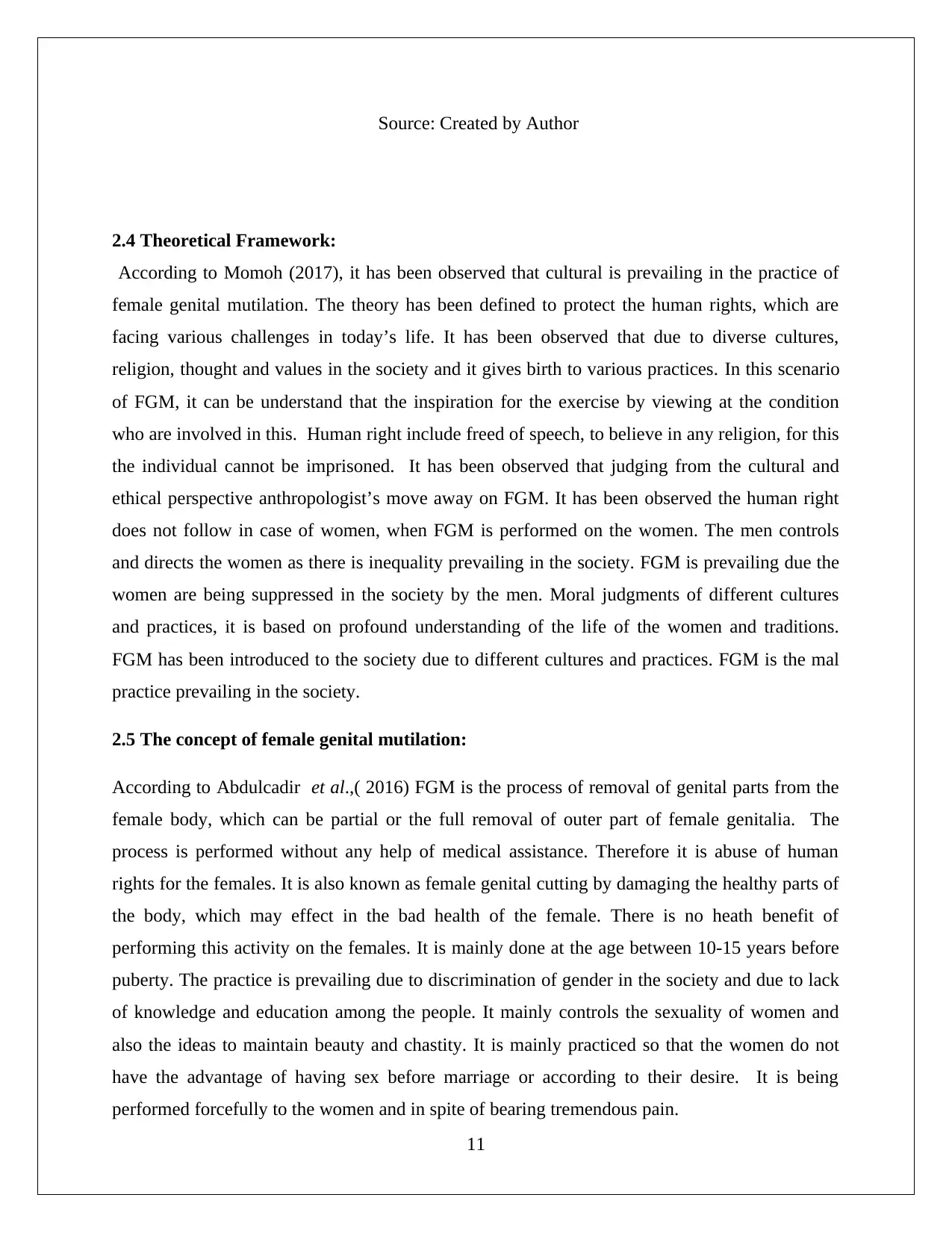
Source: Created by Author
2.4 Theoretical Framework:
According to Momoh (2017), it has been observed that cultural is prevailing in the practice of
female genital mutilation. The theory has been defined to protect the human rights, which are
facing various challenges in today’s life. It has been observed that due to diverse cultures,
religion, thought and values in the society and it gives birth to various practices. In this scenario
of FGM, it can be understand that the inspiration for the exercise by viewing at the condition
who are involved in this. Human right include freed of speech, to believe in any religion, for this
the individual cannot be imprisoned. It has been observed that judging from the cultural and
ethical perspective anthropologist’s move away on FGM. It has been observed the human right
does not follow in case of women, when FGM is performed on the women. The men controls
and directs the women as there is inequality prevailing in the society. FGM is prevailing due the
women are being suppressed in the society by the men. Moral judgments of different cultures
and practices, it is based on profound understanding of the life of the women and traditions.
FGM has been introduced to the society due to different cultures and practices. FGM is the mal
practice prevailing in the society.
2.5 The concept of female genital mutilation:
According to Abdulcadir et al.,( 2016) FGM is the process of removal of genital parts from the
female body, which can be partial or the full removal of outer part of female genitalia. The
process is performed without any help of medical assistance. Therefore it is abuse of human
rights for the females. It is also known as female genital cutting by damaging the healthy parts of
the body, which may effect in the bad health of the female. There is no heath benefit of
performing this activity on the females. It is mainly done at the age between 10-15 years before
puberty. The practice is prevailing due to discrimination of gender in the society and due to lack
of knowledge and education among the people. It mainly controls the sexuality of women and
also the ideas to maintain beauty and chastity. It is mainly practiced so that the women do not
have the advantage of having sex before marriage or according to their desire. It is being
performed forcefully to the women and in spite of bearing tremendous pain.
11
2.4 Theoretical Framework:
According to Momoh (2017), it has been observed that cultural is prevailing in the practice of
female genital mutilation. The theory has been defined to protect the human rights, which are
facing various challenges in today’s life. It has been observed that due to diverse cultures,
religion, thought and values in the society and it gives birth to various practices. In this scenario
of FGM, it can be understand that the inspiration for the exercise by viewing at the condition
who are involved in this. Human right include freed of speech, to believe in any religion, for this
the individual cannot be imprisoned. It has been observed that judging from the cultural and
ethical perspective anthropologist’s move away on FGM. It has been observed the human right
does not follow in case of women, when FGM is performed on the women. The men controls
and directs the women as there is inequality prevailing in the society. FGM is prevailing due the
women are being suppressed in the society by the men. Moral judgments of different cultures
and practices, it is based on profound understanding of the life of the women and traditions.
FGM has been introduced to the society due to different cultures and practices. FGM is the mal
practice prevailing in the society.
2.5 The concept of female genital mutilation:
According to Abdulcadir et al.,( 2016) FGM is the process of removal of genital parts from the
female body, which can be partial or the full removal of outer part of female genitalia. The
process is performed without any help of medical assistance. Therefore it is abuse of human
rights for the females. It is also known as female genital cutting by damaging the healthy parts of
the body, which may effect in the bad health of the female. There is no heath benefit of
performing this activity on the females. It is mainly done at the age between 10-15 years before
puberty. The practice is prevailing due to discrimination of gender in the society and due to lack
of knowledge and education among the people. It mainly controls the sexuality of women and
also the ideas to maintain beauty and chastity. It is mainly practiced so that the women do not
have the advantage of having sex before marriage or according to their desire. It is being
performed forcefully to the women and in spite of bearing tremendous pain.
11
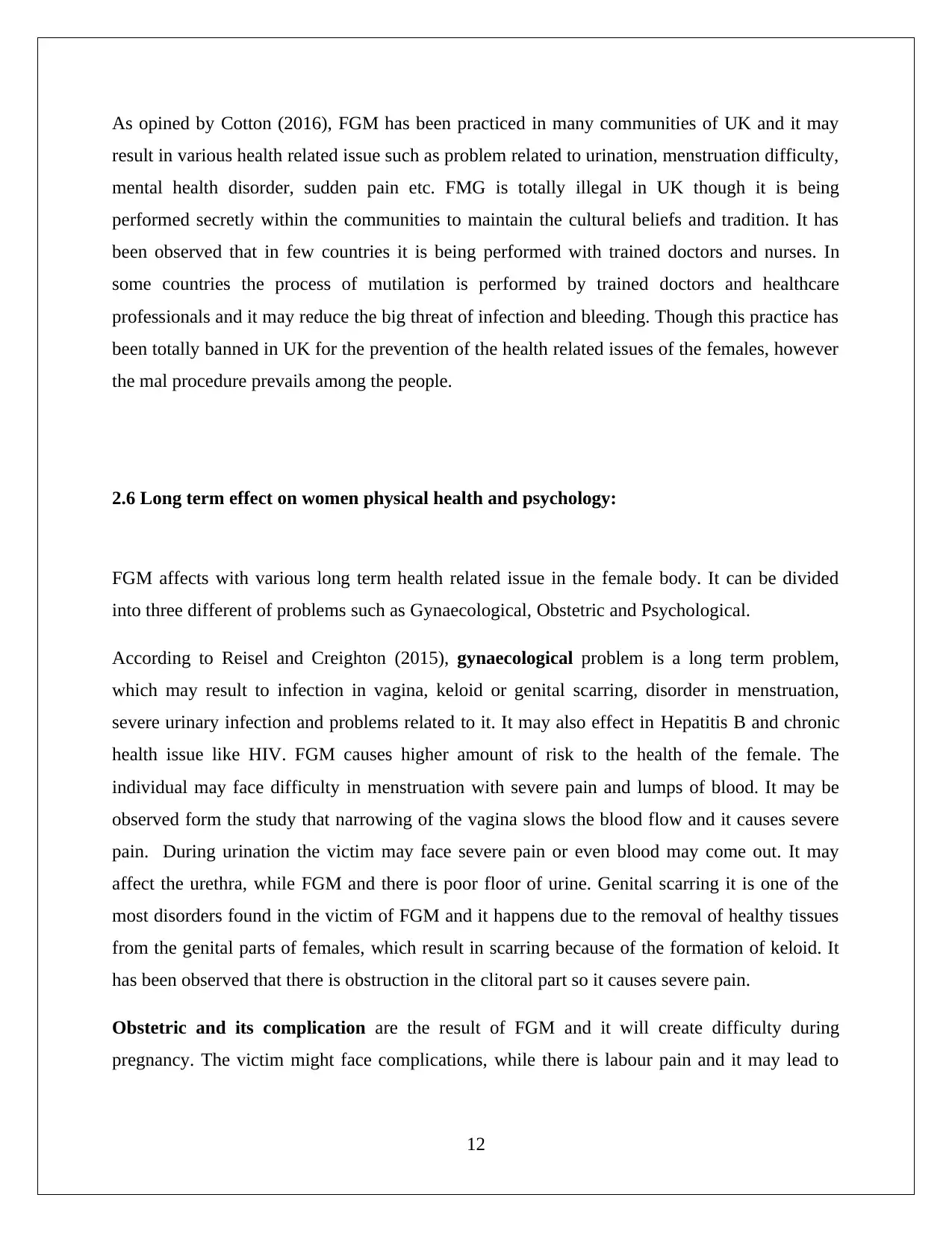
As opined by Cotton (2016), FGM has been practiced in many communities of UK and it may
result in various health related issue such as problem related to urination, menstruation difficulty,
mental health disorder, sudden pain etc. FMG is totally illegal in UK though it is being
performed secretly within the communities to maintain the cultural beliefs and tradition. It has
been observed that in few countries it is being performed with trained doctors and nurses. In
some countries the process of mutilation is performed by trained doctors and healthcare
professionals and it may reduce the big threat of infection and bleeding. Though this practice has
been totally banned in UK for the prevention of the health related issues of the females, however
the mal procedure prevails among the people.
2.6 Long term effect on women physical health and psychology:
FGM affects with various long term health related issue in the female body. It can be divided
into three different of problems such as Gynaecological, Obstetric and Psychological.
According to Reisel and Creighton (2015), gynaecological problem is a long term problem,
which may result to infection in vagina, keloid or genital scarring, disorder in menstruation,
severe urinary infection and problems related to it. It may also effect in Hepatitis B and chronic
health issue like HIV. FGM causes higher amount of risk to the health of the female. The
individual may face difficulty in menstruation with severe pain and lumps of blood. It may be
observed form the study that narrowing of the vagina slows the blood flow and it causes severe
pain. During urination the victim may face severe pain or even blood may come out. It may
affect the urethra, while FGM and there is poor floor of urine. Genital scarring it is one of the
most disorders found in the victim of FGM and it happens due to the removal of healthy tissues
from the genital parts of females, which result in scarring because of the formation of keloid. It
has been observed that there is obstruction in the clitoral part so it causes severe pain.
Obstetric and its complication are the result of FGM and it will create difficulty during
pregnancy. The victim might face complications, while there is labour pain and it may lead to
12
result in various health related issue such as problem related to urination, menstruation difficulty,
mental health disorder, sudden pain etc. FMG is totally illegal in UK though it is being
performed secretly within the communities to maintain the cultural beliefs and tradition. It has
been observed that in few countries it is being performed with trained doctors and nurses. In
some countries the process of mutilation is performed by trained doctors and healthcare
professionals and it may reduce the big threat of infection and bleeding. Though this practice has
been totally banned in UK for the prevention of the health related issues of the females, however
the mal procedure prevails among the people.
2.6 Long term effect on women physical health and psychology:
FGM affects with various long term health related issue in the female body. It can be divided
into three different of problems such as Gynaecological, Obstetric and Psychological.
According to Reisel and Creighton (2015), gynaecological problem is a long term problem,
which may result to infection in vagina, keloid or genital scarring, disorder in menstruation,
severe urinary infection and problems related to it. It may also effect in Hepatitis B and chronic
health issue like HIV. FGM causes higher amount of risk to the health of the female. The
individual may face difficulty in menstruation with severe pain and lumps of blood. It may be
observed form the study that narrowing of the vagina slows the blood flow and it causes severe
pain. During urination the victim may face severe pain or even blood may come out. It may
affect the urethra, while FGM and there is poor floor of urine. Genital scarring it is one of the
most disorders found in the victim of FGM and it happens due to the removal of healthy tissues
from the genital parts of females, which result in scarring because of the formation of keloid. It
has been observed that there is obstruction in the clitoral part so it causes severe pain.
Obstetric and its complication are the result of FGM and it will create difficulty during
pregnancy. The victim might face complications, while there is labour pain and it may lead to
12
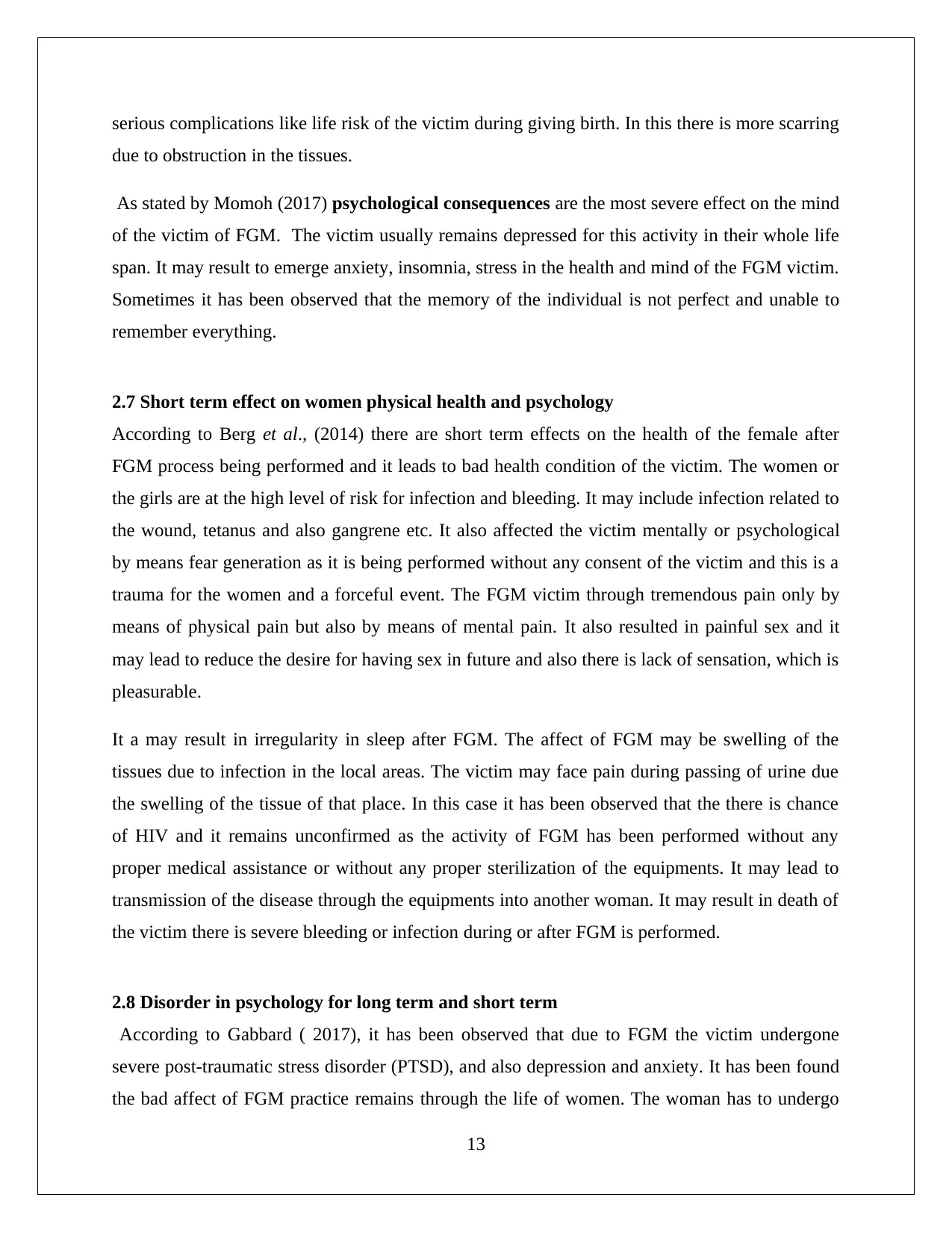
serious complications like life risk of the victim during giving birth. In this there is more scarring
due to obstruction in the tissues.
As stated by Momoh (2017) psychological consequences are the most severe effect on the mind
of the victim of FGM. The victim usually remains depressed for this activity in their whole life
span. It may result to emerge anxiety, insomnia, stress in the health and mind of the FGM victim.
Sometimes it has been observed that the memory of the individual is not perfect and unable to
remember everything.
2.7 Short term effect on women physical health and psychology
According to Berg et al., (2014) there are short term effects on the health of the female after
FGM process being performed and it leads to bad health condition of the victim. The women or
the girls are at the high level of risk for infection and bleeding. It may include infection related to
the wound, tetanus and also gangrene etc. It also affected the victim mentally or psychological
by means fear generation as it is being performed without any consent of the victim and this is a
trauma for the women and a forceful event. The FGM victim through tremendous pain only by
means of physical pain but also by means of mental pain. It also resulted in painful sex and it
may lead to reduce the desire for having sex in future and also there is lack of sensation, which is
pleasurable.
It a may result in irregularity in sleep after FGM. The affect of FGM may be swelling of the
tissues due to infection in the local areas. The victim may face pain during passing of urine due
the swelling of the tissue of that place. In this case it has been observed that the there is chance
of HIV and it remains unconfirmed as the activity of FGM has been performed without any
proper medical assistance or without any proper sterilization of the equipments. It may lead to
transmission of the disease through the equipments into another woman. It may result in death of
the victim there is severe bleeding or infection during or after FGM is performed.
2.8 Disorder in psychology for long term and short term
According to Gabbard ( 2017), it has been observed that due to FGM the victim undergone
severe post-traumatic stress disorder (PTSD), and also depression and anxiety. It has been found
the bad affect of FGM practice remains through the life of women. The woman has to undergo
13
due to obstruction in the tissues.
As stated by Momoh (2017) psychological consequences are the most severe effect on the mind
of the victim of FGM. The victim usually remains depressed for this activity in their whole life
span. It may result to emerge anxiety, insomnia, stress in the health and mind of the FGM victim.
Sometimes it has been observed that the memory of the individual is not perfect and unable to
remember everything.
2.7 Short term effect on women physical health and psychology
According to Berg et al., (2014) there are short term effects on the health of the female after
FGM process being performed and it leads to bad health condition of the victim. The women or
the girls are at the high level of risk for infection and bleeding. It may include infection related to
the wound, tetanus and also gangrene etc. It also affected the victim mentally or psychological
by means fear generation as it is being performed without any consent of the victim and this is a
trauma for the women and a forceful event. The FGM victim through tremendous pain only by
means of physical pain but also by means of mental pain. It also resulted in painful sex and it
may lead to reduce the desire for having sex in future and also there is lack of sensation, which is
pleasurable.
It a may result in irregularity in sleep after FGM. The affect of FGM may be swelling of the
tissues due to infection in the local areas. The victim may face pain during passing of urine due
the swelling of the tissue of that place. In this case it has been observed that the there is chance
of HIV and it remains unconfirmed as the activity of FGM has been performed without any
proper medical assistance or without any proper sterilization of the equipments. It may lead to
transmission of the disease through the equipments into another woman. It may result in death of
the victim there is severe bleeding or infection during or after FGM is performed.
2.8 Disorder in psychology for long term and short term
According to Gabbard ( 2017), it has been observed that due to FGM the victim undergone
severe post-traumatic stress disorder (PTSD), and also depression and anxiety. It has been found
the bad affect of FGM practice remains through the life of women. The woman has to undergo
13
Paraphrase This Document
Need a fresh take? Get an instant paraphrase of this document with our AI Paraphraser
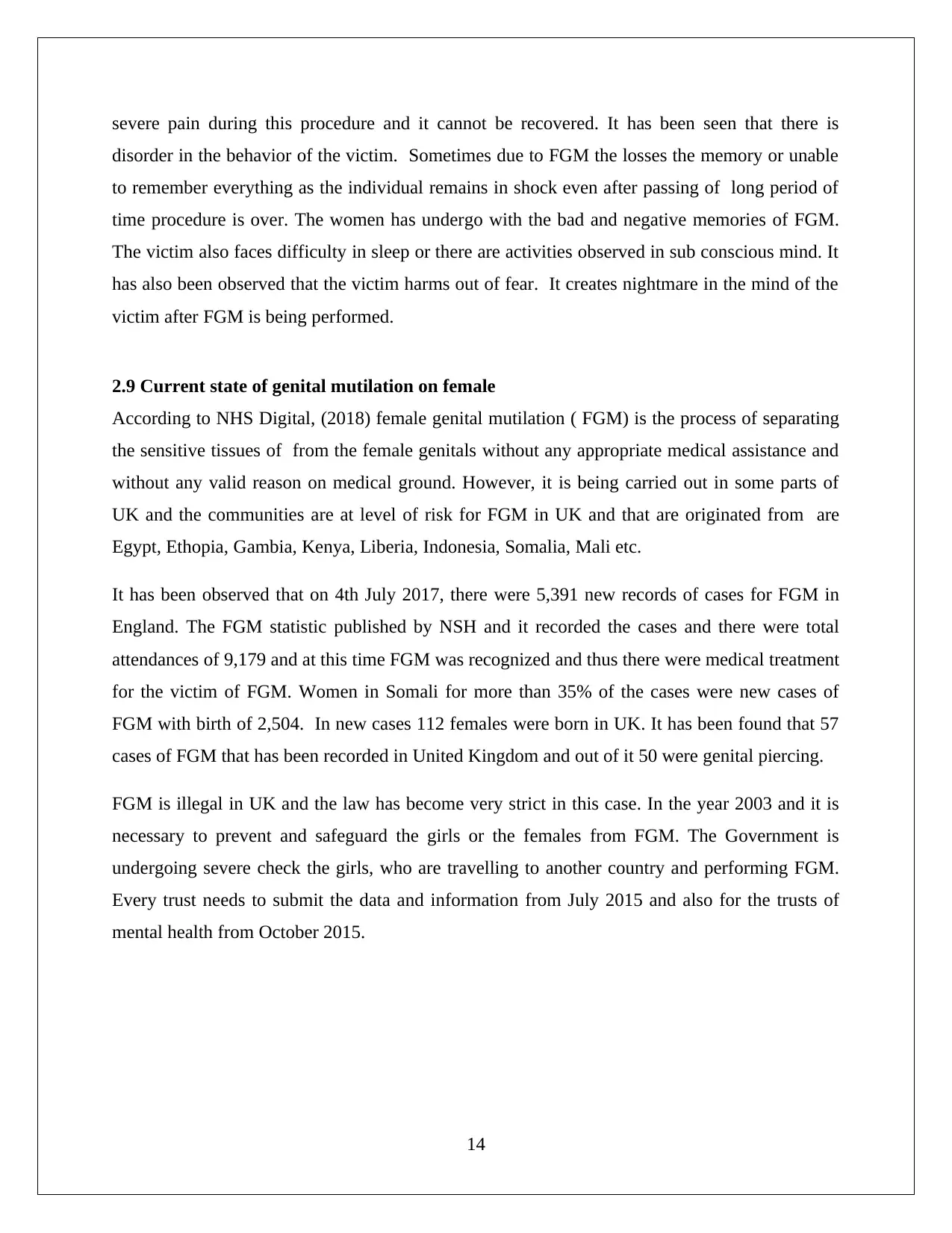
severe pain during this procedure and it cannot be recovered. It has been seen that there is
disorder in the behavior of the victim. Sometimes due to FGM the losses the memory or unable
to remember everything as the individual remains in shock even after passing of long period of
time procedure is over. The women has undergo with the bad and negative memories of FGM.
The victim also faces difficulty in sleep or there are activities observed in sub conscious mind. It
has also been observed that the victim harms out of fear. It creates nightmare in the mind of the
victim after FGM is being performed.
2.9 Current state of genital mutilation on female
According to NHS Digital, (2018) female genital mutilation ( FGM) is the process of separating
the sensitive tissues of from the female genitals without any appropriate medical assistance and
without any valid reason on medical ground. However, it is being carried out in some parts of
UK and the communities are at level of risk for FGM in UK and that are originated from are
Egypt, Ethopia, Gambia, Kenya, Liberia, Indonesia, Somalia, Mali etc.
It has been observed that on 4th July 2017, there were 5,391 new records of cases for FGM in
England. The FGM statistic published by NSH and it recorded the cases and there were total
attendances of 9,179 and at this time FGM was recognized and thus there were medical treatment
for the victim of FGM. Women in Somali for more than 35% of the cases were new cases of
FGM with birth of 2,504. In new cases 112 females were born in UK. It has been found that 57
cases of FGM that has been recorded in United Kingdom and out of it 50 were genital piercing.
FGM is illegal in UK and the law has become very strict in this case. In the year 2003 and it is
necessary to prevent and safeguard the girls or the females from FGM. The Government is
undergoing severe check the girls, who are travelling to another country and performing FGM.
Every trust needs to submit the data and information from July 2015 and also for the trusts of
mental health from October 2015.
14
disorder in the behavior of the victim. Sometimes due to FGM the losses the memory or unable
to remember everything as the individual remains in shock even after passing of long period of
time procedure is over. The women has undergo with the bad and negative memories of FGM.
The victim also faces difficulty in sleep or there are activities observed in sub conscious mind. It
has also been observed that the victim harms out of fear. It creates nightmare in the mind of the
victim after FGM is being performed.
2.9 Current state of genital mutilation on female
According to NHS Digital, (2018) female genital mutilation ( FGM) is the process of separating
the sensitive tissues of from the female genitals without any appropriate medical assistance and
without any valid reason on medical ground. However, it is being carried out in some parts of
UK and the communities are at level of risk for FGM in UK and that are originated from are
Egypt, Ethopia, Gambia, Kenya, Liberia, Indonesia, Somalia, Mali etc.
It has been observed that on 4th July 2017, there were 5,391 new records of cases for FGM in
England. The FGM statistic published by NSH and it recorded the cases and there were total
attendances of 9,179 and at this time FGM was recognized and thus there were medical treatment
for the victim of FGM. Women in Somali for more than 35% of the cases were new cases of
FGM with birth of 2,504. In new cases 112 females were born in UK. It has been found that 57
cases of FGM that has been recorded in United Kingdom and out of it 50 were genital piercing.
FGM is illegal in UK and the law has become very strict in this case. In the year 2003 and it is
necessary to prevent and safeguard the girls or the females from FGM. The Government is
undergoing severe check the girls, who are travelling to another country and performing FGM.
Every trust needs to submit the data and information from July 2015 and also for the trusts of
mental health from October 2015.
14
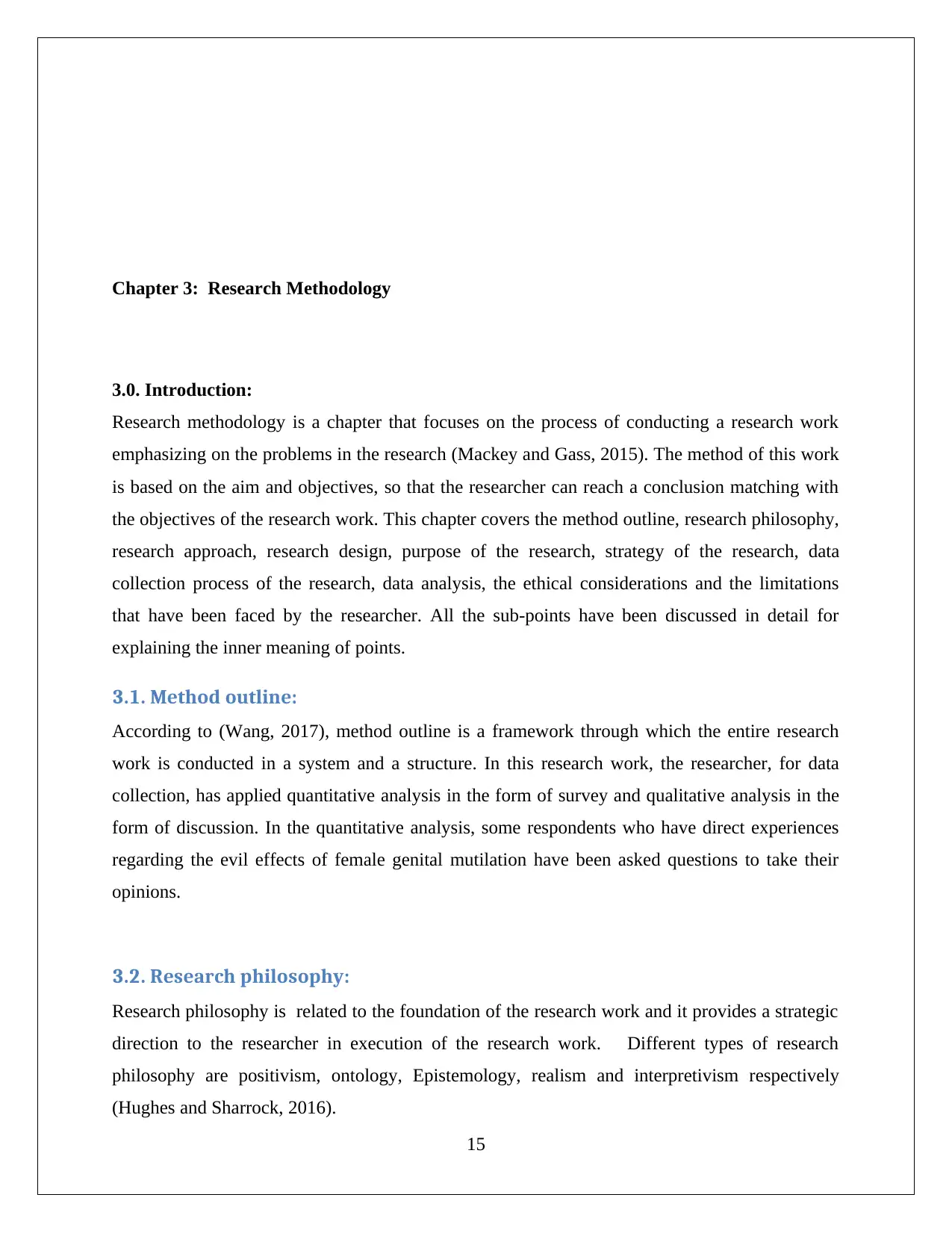
Chapter 3: Research Methodology
3.0. Introduction:
Research methodology is a chapter that focuses on the process of conducting a research work
emphasizing on the problems in the research (Mackey and Gass, 2015). The method of this work
is based on the aim and objectives, so that the researcher can reach a conclusion matching with
the objectives of the research work. This chapter covers the method outline, research philosophy,
research approach, research design, purpose of the research, strategy of the research, data
collection process of the research, data analysis, the ethical considerations and the limitations
that have been faced by the researcher. All the sub-points have been discussed in detail for
explaining the inner meaning of points.
3.1. Method outline:
According to (Wang, 2017), method outline is a framework through which the entire research
work is conducted in a system and a structure. In this research work, the researcher, for data
collection, has applied quantitative analysis in the form of survey and qualitative analysis in the
form of discussion. In the quantitative analysis, some respondents who have direct experiences
regarding the evil effects of female genital mutilation have been asked questions to take their
opinions.
3.2. Research philosophy:
Research philosophy is related to the foundation of the research work and it provides a strategic
direction to the researcher in execution of the research work. Different types of research
philosophy are positivism, ontology, Epistemology, realism and interpretivism respectively
(Hughes and Sharrock, 2016).
15
3.0. Introduction:
Research methodology is a chapter that focuses on the process of conducting a research work
emphasizing on the problems in the research (Mackey and Gass, 2015). The method of this work
is based on the aim and objectives, so that the researcher can reach a conclusion matching with
the objectives of the research work. This chapter covers the method outline, research philosophy,
research approach, research design, purpose of the research, strategy of the research, data
collection process of the research, data analysis, the ethical considerations and the limitations
that have been faced by the researcher. All the sub-points have been discussed in detail for
explaining the inner meaning of points.
3.1. Method outline:
According to (Wang, 2017), method outline is a framework through which the entire research
work is conducted in a system and a structure. In this research work, the researcher, for data
collection, has applied quantitative analysis in the form of survey and qualitative analysis in the
form of discussion. In the quantitative analysis, some respondents who have direct experiences
regarding the evil effects of female genital mutilation have been asked questions to take their
opinions.
3.2. Research philosophy:
Research philosophy is related to the foundation of the research work and it provides a strategic
direction to the researcher in execution of the research work. Different types of research
philosophy are positivism, ontology, Epistemology, realism and interpretivism respectively
(Hughes and Sharrock, 2016).
15

3.2.1. Justification of the chosen philosophy:
The positivism approach in this research philosophy has been taken. Some women having direct
experience related to the research subject and some health and social care workers have been
selected to ask questions and positive results have expected to come from such survey and
discussion.
3.3. Research approach:
Research approach is the second layer of the research onion. It is a process that involves data
collection, data analysis and data interpretation. There are two types of research approaches – the
inductive approaches and the deductive approaches (Sekaran and Bougie, 2016). Through an
inductive approach, new theory is generated from data and through deductive approach, the
theory is tested.
3.3.1. Justification of the chosen research approach:
In this research work, the deductive research approach has been chosen, because the opinion of
the scholar is deduced to reach an individual inference.
3.4. Research Design
Research design tells the researcher what the tools will be used to collect data the ways through
which the tools will be used in the research work. There are three types of research design-
exploratory, explanatory and the descriptive design of research. The exploratory research is done
to study the problem, which has not been studied well previously. Thus, the research design is
developed. Through explanatory research, the researcher researches on different ideas and
understand different reasons and effects. Through descriptive study, the researcher depicts the
participants in a descriptive way in the research work (Marczyk et al., 2017).
16
The positivism approach in this research philosophy has been taken. Some women having direct
experience related to the research subject and some health and social care workers have been
selected to ask questions and positive results have expected to come from such survey and
discussion.
3.3. Research approach:
Research approach is the second layer of the research onion. It is a process that involves data
collection, data analysis and data interpretation. There are two types of research approaches – the
inductive approaches and the deductive approaches (Sekaran and Bougie, 2016). Through an
inductive approach, new theory is generated from data and through deductive approach, the
theory is tested.
3.3.1. Justification of the chosen research approach:
In this research work, the deductive research approach has been chosen, because the opinion of
the scholar is deduced to reach an individual inference.
3.4. Research Design
Research design tells the researcher what the tools will be used to collect data the ways through
which the tools will be used in the research work. There are three types of research design-
exploratory, explanatory and the descriptive design of research. The exploratory research is done
to study the problem, which has not been studied well previously. Thus, the research design is
developed. Through explanatory research, the researcher researches on different ideas and
understand different reasons and effects. Through descriptive study, the researcher depicts the
participants in a descriptive way in the research work (Marczyk et al., 2017).
16
Secure Best Marks with AI Grader
Need help grading? Try our AI Grader for instant feedback on your assignments.
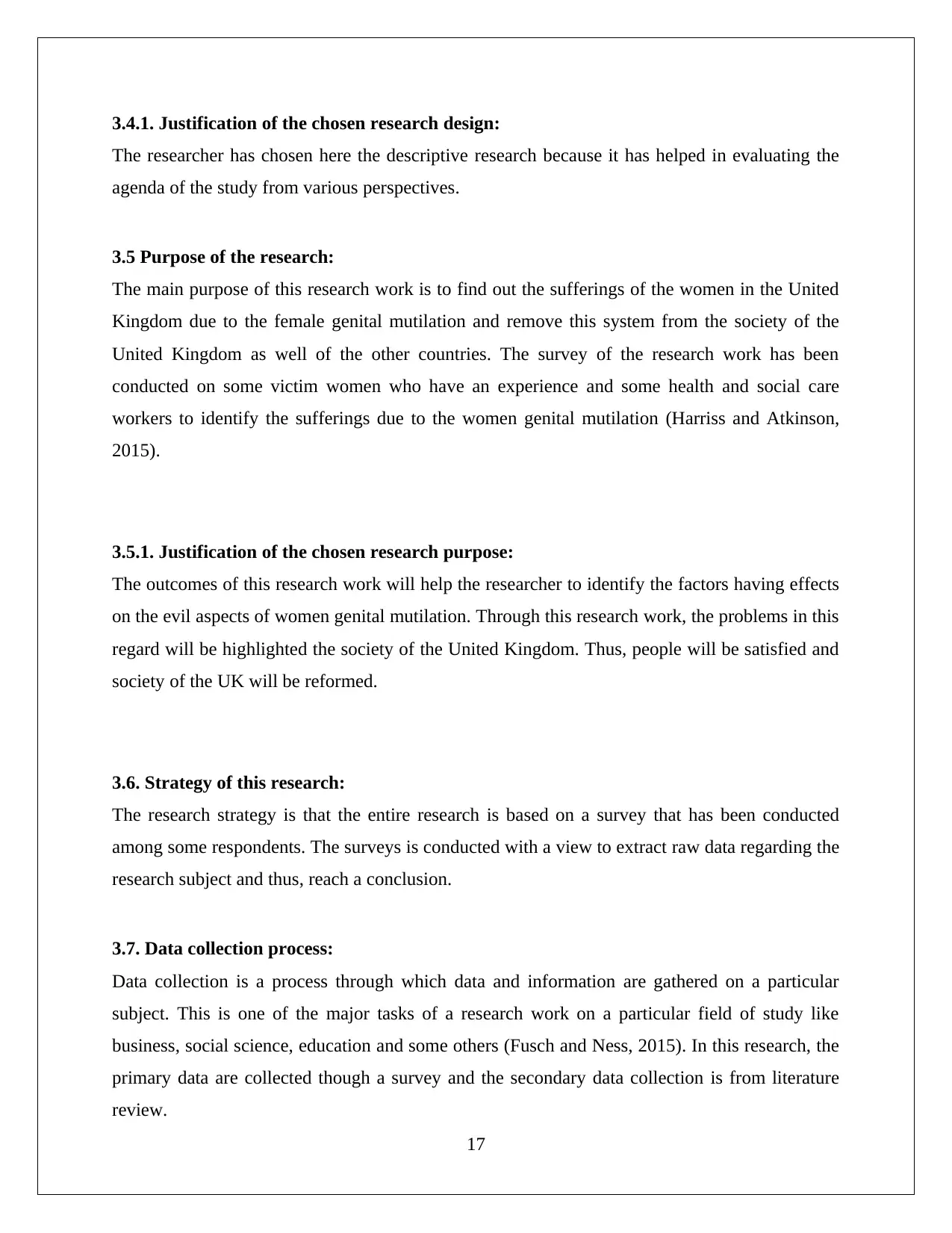
3.4.1. Justification of the chosen research design:
The researcher has chosen here the descriptive research because it has helped in evaluating the
agenda of the study from various perspectives.
3.5 Purpose of the research:
The main purpose of this research work is to find out the sufferings of the women in the United
Kingdom due to the female genital mutilation and remove this system from the society of the
United Kingdom as well of the other countries. The survey of the research work has been
conducted on some victim women who have an experience and some health and social care
workers to identify the sufferings due to the women genital mutilation (Harriss and Atkinson,
2015).
3.5.1. Justification of the chosen research purpose:
The outcomes of this research work will help the researcher to identify the factors having effects
on the evil aspects of women genital mutilation. Through this research work, the problems in this
regard will be highlighted the society of the United Kingdom. Thus, people will be satisfied and
society of the UK will be reformed.
3.6. Strategy of this research:
The research strategy is that the entire research is based on a survey that has been conducted
among some respondents. The surveys is conducted with a view to extract raw data regarding the
research subject and thus, reach a conclusion.
3.7. Data collection process:
Data collection is a process through which data and information are gathered on a particular
subject. This is one of the major tasks of a research work on a particular field of study like
business, social science, education and some others (Fusch and Ness, 2015). In this research, the
primary data are collected though a survey and the secondary data collection is from literature
review.
17
The researcher has chosen here the descriptive research because it has helped in evaluating the
agenda of the study from various perspectives.
3.5 Purpose of the research:
The main purpose of this research work is to find out the sufferings of the women in the United
Kingdom due to the female genital mutilation and remove this system from the society of the
United Kingdom as well of the other countries. The survey of the research work has been
conducted on some victim women who have an experience and some health and social care
workers to identify the sufferings due to the women genital mutilation (Harriss and Atkinson,
2015).
3.5.1. Justification of the chosen research purpose:
The outcomes of this research work will help the researcher to identify the factors having effects
on the evil aspects of women genital mutilation. Through this research work, the problems in this
regard will be highlighted the society of the United Kingdom. Thus, people will be satisfied and
society of the UK will be reformed.
3.6. Strategy of this research:
The research strategy is that the entire research is based on a survey that has been conducted
among some respondents. The surveys is conducted with a view to extract raw data regarding the
research subject and thus, reach a conclusion.
3.7. Data collection process:
Data collection is a process through which data and information are gathered on a particular
subject. This is one of the major tasks of a research work on a particular field of study like
business, social science, education and some others (Fusch and Ness, 2015). In this research, the
primary data are collected though a survey and the secondary data collection is from literature
review.
17
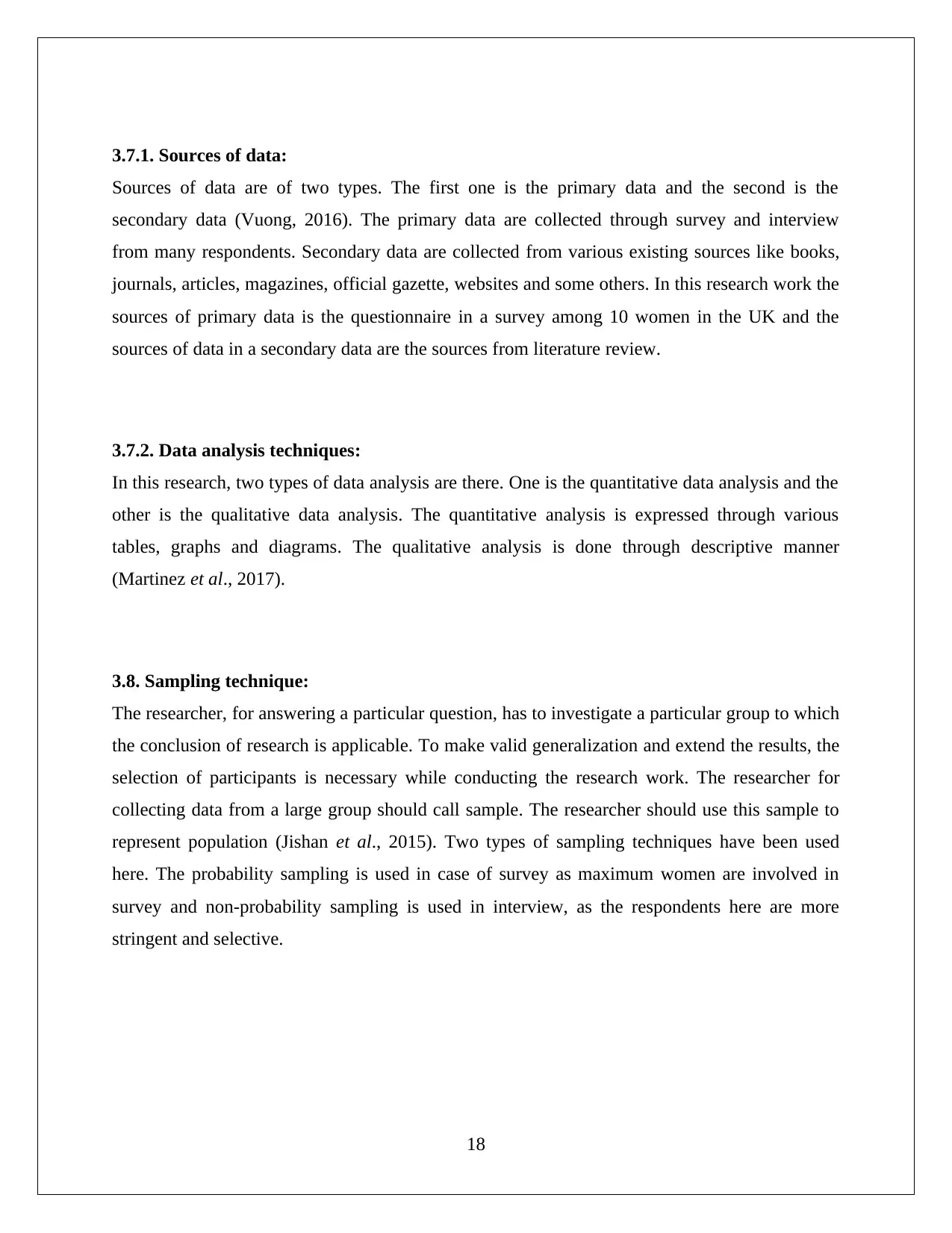
3.7.1. Sources of data:
Sources of data are of two types. The first one is the primary data and the second is the
secondary data (Vuong, 2016). The primary data are collected through survey and interview
from many respondents. Secondary data are collected from various existing sources like books,
journals, articles, magazines, official gazette, websites and some others. In this research work the
sources of primary data is the questionnaire in a survey among 10 women in the UK and the
sources of data in a secondary data are the sources from literature review.
3.7.2. Data analysis techniques:
In this research, two types of data analysis are there. One is the quantitative data analysis and the
other is the qualitative data analysis. The quantitative analysis is expressed through various
tables, graphs and diagrams. The qualitative analysis is done through descriptive manner
(Martinez et al., 2017).
3.8. Sampling technique:
The researcher, for answering a particular question, has to investigate a particular group to which
the conclusion of research is applicable. To make valid generalization and extend the results, the
selection of participants is necessary while conducting the research work. The researcher for
collecting data from a large group should call sample. The researcher should use this sample to
represent population (Jishan et al., 2015). Two types of sampling techniques have been used
here. The probability sampling is used in case of survey as maximum women are involved in
survey and non-probability sampling is used in interview, as the respondents here are more
stringent and selective.
18
Sources of data are of two types. The first one is the primary data and the second is the
secondary data (Vuong, 2016). The primary data are collected through survey and interview
from many respondents. Secondary data are collected from various existing sources like books,
journals, articles, magazines, official gazette, websites and some others. In this research work the
sources of primary data is the questionnaire in a survey among 10 women in the UK and the
sources of data in a secondary data are the sources from literature review.
3.7.2. Data analysis techniques:
In this research, two types of data analysis are there. One is the quantitative data analysis and the
other is the qualitative data analysis. The quantitative analysis is expressed through various
tables, graphs and diagrams. The qualitative analysis is done through descriptive manner
(Martinez et al., 2017).
3.8. Sampling technique:
The researcher, for answering a particular question, has to investigate a particular group to which
the conclusion of research is applicable. To make valid generalization and extend the results, the
selection of participants is necessary while conducting the research work. The researcher for
collecting data from a large group should call sample. The researcher should use this sample to
represent population (Jishan et al., 2015). Two types of sampling techniques have been used
here. The probability sampling is used in case of survey as maximum women are involved in
survey and non-probability sampling is used in interview, as the respondents here are more
stringent and selective.
18

3.8.2. Sample size:
In this research work, 10 women who have some direct experience regarding the survey subject
have been selected and asked some questions on the research subject. 50 care workers have been
selected for survey and have been asked questions.
3.11. Ethical consideration:
According to the Data Protection Act, 1998, ethical consideration is a mandatory field in any
type of research work. A researcher has to consider some ethical issues in research work. Firstly,
as the research work is based on a sensitive issue, the purpose of the ethical consideration is to
maintain the confidentiality of the respondents in research work. Secondly, the researcher has to
consider the fact that the data are not used for any unlawful purpose. Finally, the data extracted
and used in research work have to be destroyed after the completion of the project for the safety
of and personal protection of the respondents (Bhat and Deshpande, 2017).
3.12. Research limitation:
The researcher has faced some limitations while conducting the survey and the interview. Firstly,
the research work has to be completed within a stipulated time and hence, the time is very short
and secondly the budget is small according to the size of the research work (Campbell and
Stanley, 2015). Hence, the entire research work has to be completed in a single umbrella to save
money.
3.13. Gantt chart:
Research
components
1st week 2nd week 3rd week 4th week 5th week 6th week
Identification
of the research
topic
Discussion of
19
In this research work, 10 women who have some direct experience regarding the survey subject
have been selected and asked some questions on the research subject. 50 care workers have been
selected for survey and have been asked questions.
3.11. Ethical consideration:
According to the Data Protection Act, 1998, ethical consideration is a mandatory field in any
type of research work. A researcher has to consider some ethical issues in research work. Firstly,
as the research work is based on a sensitive issue, the purpose of the ethical consideration is to
maintain the confidentiality of the respondents in research work. Secondly, the researcher has to
consider the fact that the data are not used for any unlawful purpose. Finally, the data extracted
and used in research work have to be destroyed after the completion of the project for the safety
of and personal protection of the respondents (Bhat and Deshpande, 2017).
3.12. Research limitation:
The researcher has faced some limitations while conducting the survey and the interview. Firstly,
the research work has to be completed within a stipulated time and hence, the time is very short
and secondly the budget is small according to the size of the research work (Campbell and
Stanley, 2015). Hence, the entire research work has to be completed in a single umbrella to save
money.
3.13. Gantt chart:
Research
components
1st week 2nd week 3rd week 4th week 5th week 6th week
Identification
of the research
topic
Discussion of
19
Paraphrase This Document
Need a fresh take? Get an instant paraphrase of this document with our AI Paraphraser
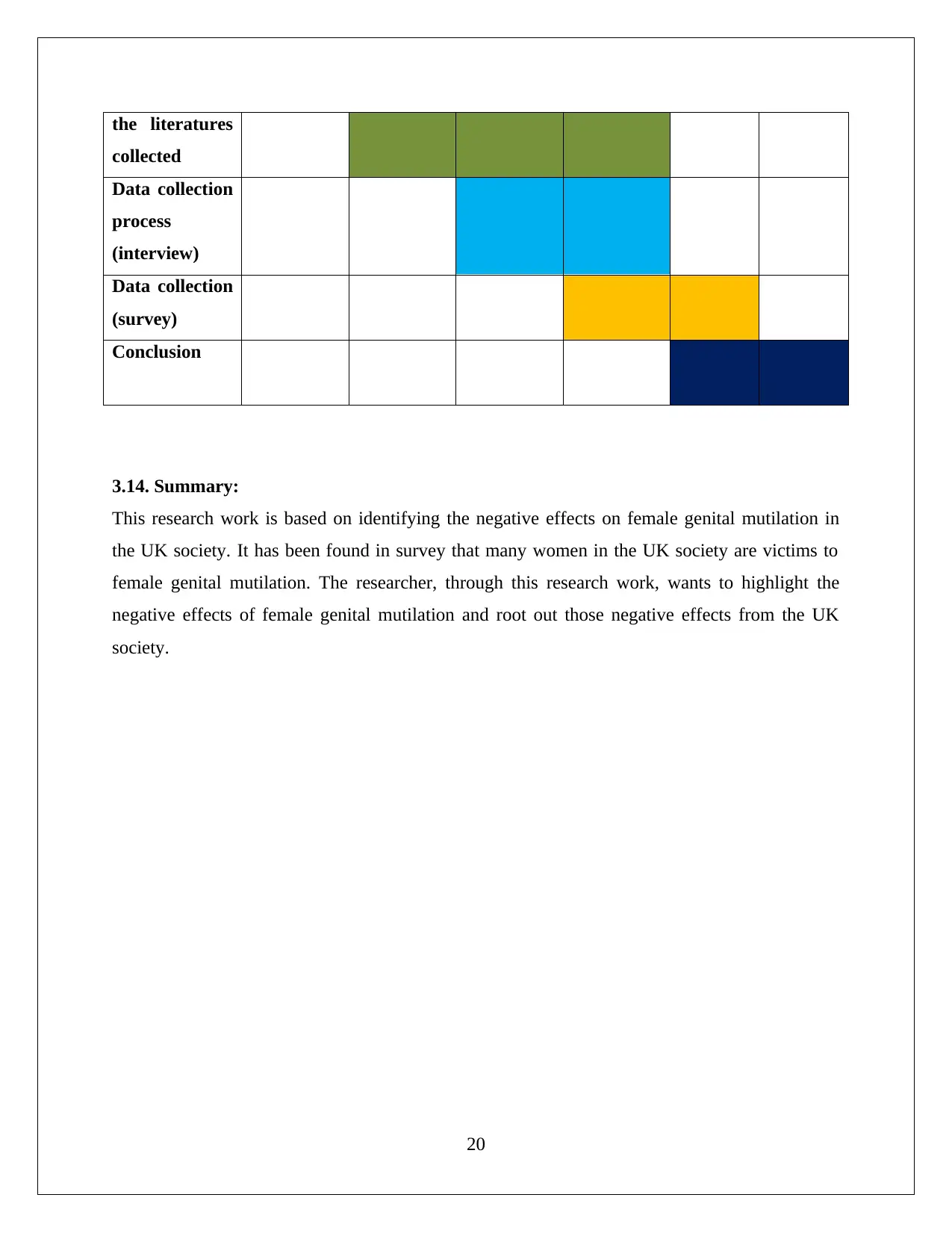
the literatures
collected
Data collection
process
(interview)
Data collection
(survey)
Conclusion
3.14. Summary:
This research work is based on identifying the negative effects on female genital mutilation in
the UK society. It has been found in survey that many women in the UK society are victims to
female genital mutilation. The researcher, through this research work, wants to highlight the
negative effects of female genital mutilation and root out those negative effects from the UK
society.
20
collected
Data collection
process
(interview)
Data collection
(survey)
Conclusion
3.14. Summary:
This research work is based on identifying the negative effects on female genital mutilation in
the UK society. It has been found in survey that many women in the UK society are victims to
female genital mutilation. The researcher, through this research work, wants to highlight the
negative effects of female genital mutilation and root out those negative effects from the UK
society.
20
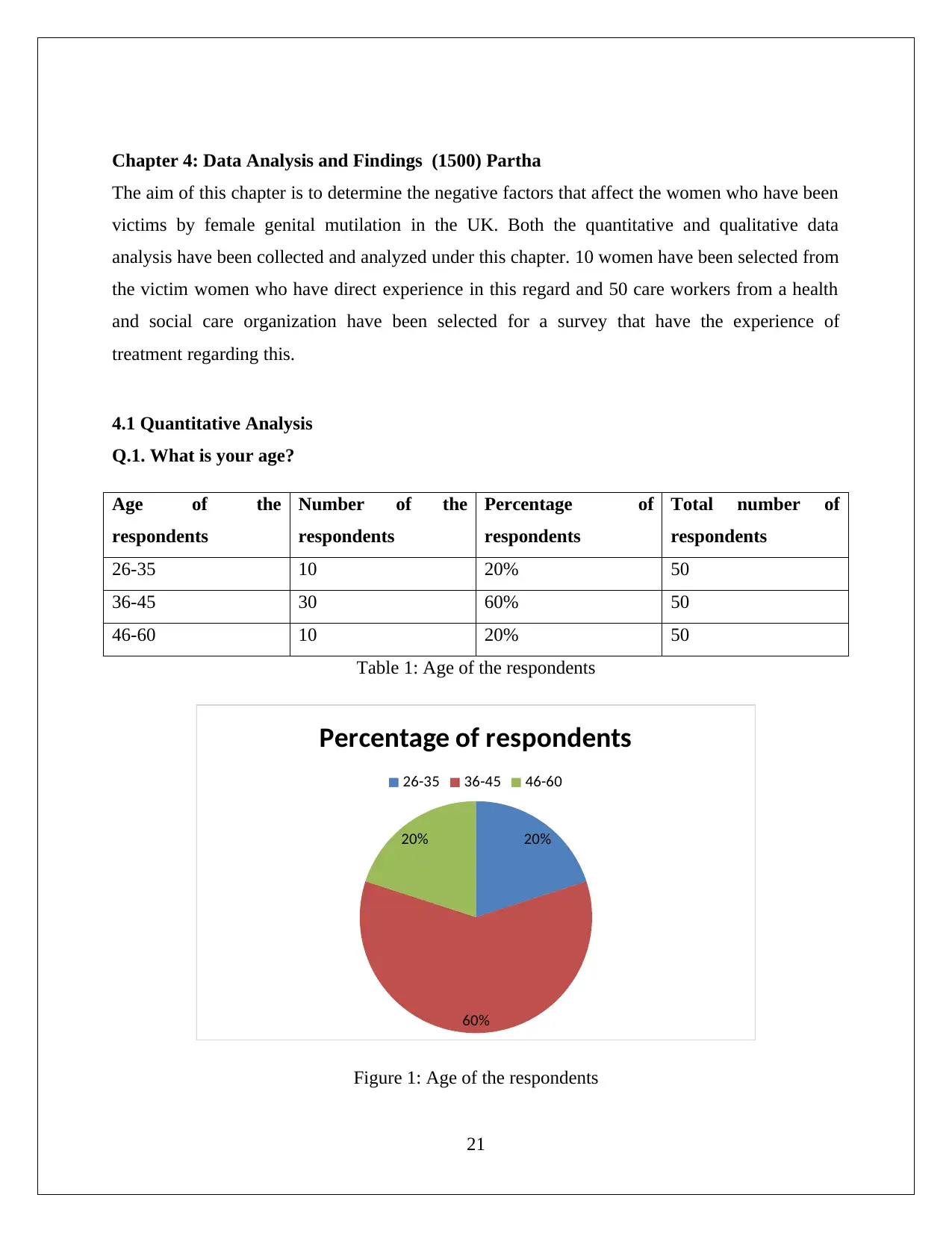
Chapter 4: Data Analysis and Findings (1500) Partha
The aim of this chapter is to determine the negative factors that affect the women who have been
victims by female genital mutilation in the UK. Both the quantitative and qualitative data
analysis have been collected and analyzed under this chapter. 10 women have been selected from
the victim women who have direct experience in this regard and 50 care workers from a health
and social care organization have been selected for a survey that have the experience of
treatment regarding this.
4.1 Quantitative Analysis
Q.1. What is your age?
Age of the
respondents
Number of the
respondents
Percentage of
respondents
Total number of
respondents
26-35 10 20% 50
36-45 30 60% 50
46-60 10 20% 50
Table 1: Age of the respondents
20%
60%
20%
Percentage of respondents
26-35 36-45 46-60
Figure 1: Age of the respondents
21
The aim of this chapter is to determine the negative factors that affect the women who have been
victims by female genital mutilation in the UK. Both the quantitative and qualitative data
analysis have been collected and analyzed under this chapter. 10 women have been selected from
the victim women who have direct experience in this regard and 50 care workers from a health
and social care organization have been selected for a survey that have the experience of
treatment regarding this.
4.1 Quantitative Analysis
Q.1. What is your age?
Age of the
respondents
Number of the
respondents
Percentage of
respondents
Total number of
respondents
26-35 10 20% 50
36-45 30 60% 50
46-60 10 20% 50
Table 1: Age of the respondents
20%
60%
20%
Percentage of respondents
26-35 36-45 46-60
Figure 1: Age of the respondents
21
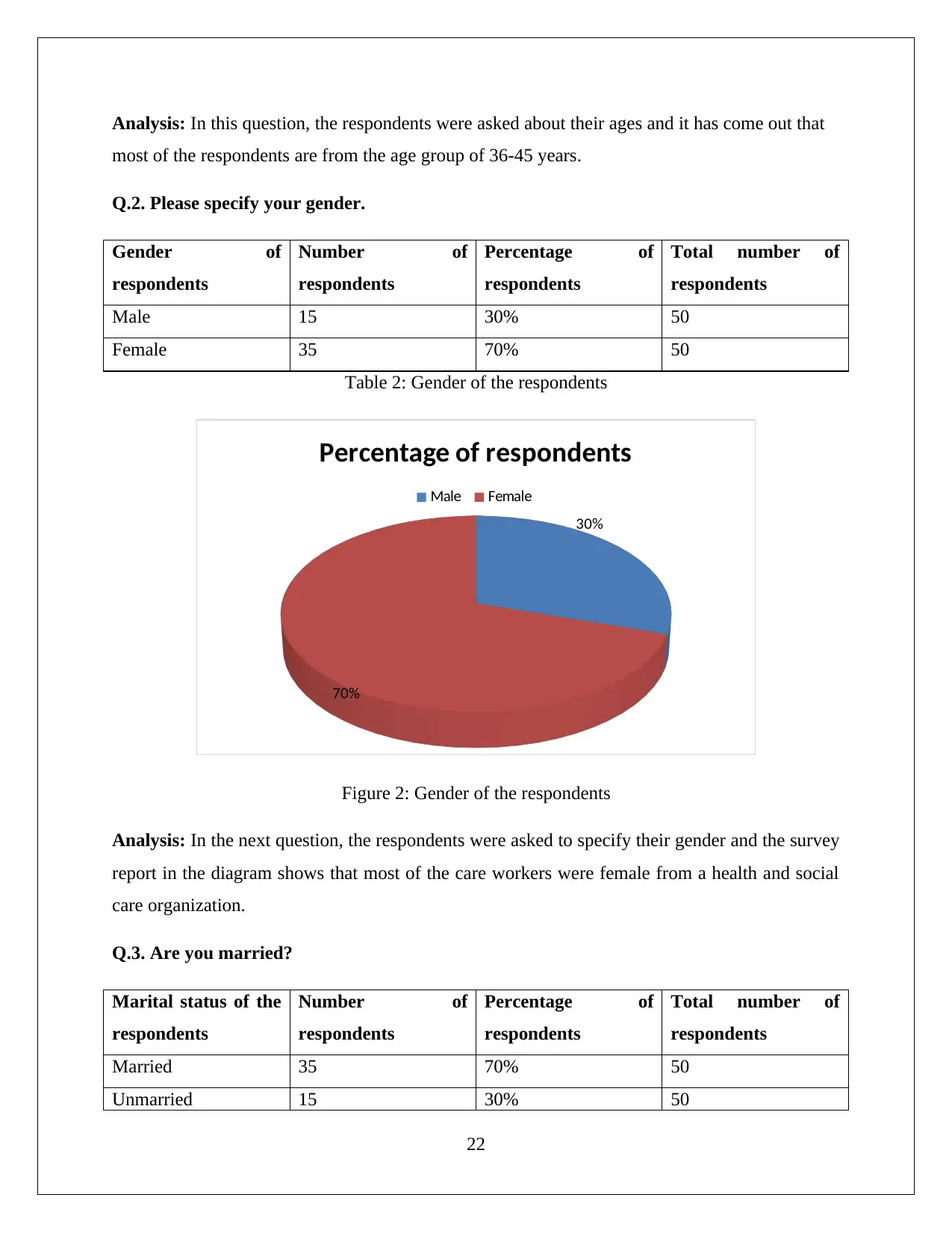
Analysis: In this question, the respondents were asked about their ages and it has come out that
most of the respondents are from the age group of 36-45 years.
Q.2. Please specify your gender.
Gender of
respondents
Number of
respondents
Percentage of
respondents
Total number of
respondents
Male 15 30% 50
Female 35 70% 50
Table 2: Gender of the respondents
30%
70%
Percentage of respondents
Male Female
Figure 2: Gender of the respondents
Analysis: In the next question, the respondents were asked to specify their gender and the survey
report in the diagram shows that most of the care workers were female from a health and social
care organization.
Q.3. Are you married?
Marital status of the
respondents
Number of
respondents
Percentage of
respondents
Total number of
respondents
Married 35 70% 50
Unmarried 15 30% 50
22
most of the respondents are from the age group of 36-45 years.
Q.2. Please specify your gender.
Gender of
respondents
Number of
respondents
Percentage of
respondents
Total number of
respondents
Male 15 30% 50
Female 35 70% 50
Table 2: Gender of the respondents
30%
70%
Percentage of respondents
Male Female
Figure 2: Gender of the respondents
Analysis: In the next question, the respondents were asked to specify their gender and the survey
report in the diagram shows that most of the care workers were female from a health and social
care organization.
Q.3. Are you married?
Marital status of the
respondents
Number of
respondents
Percentage of
respondents
Total number of
respondents
Married 35 70% 50
Unmarried 15 30% 50
22
Secure Best Marks with AI Grader
Need help grading? Try our AI Grader for instant feedback on your assignments.
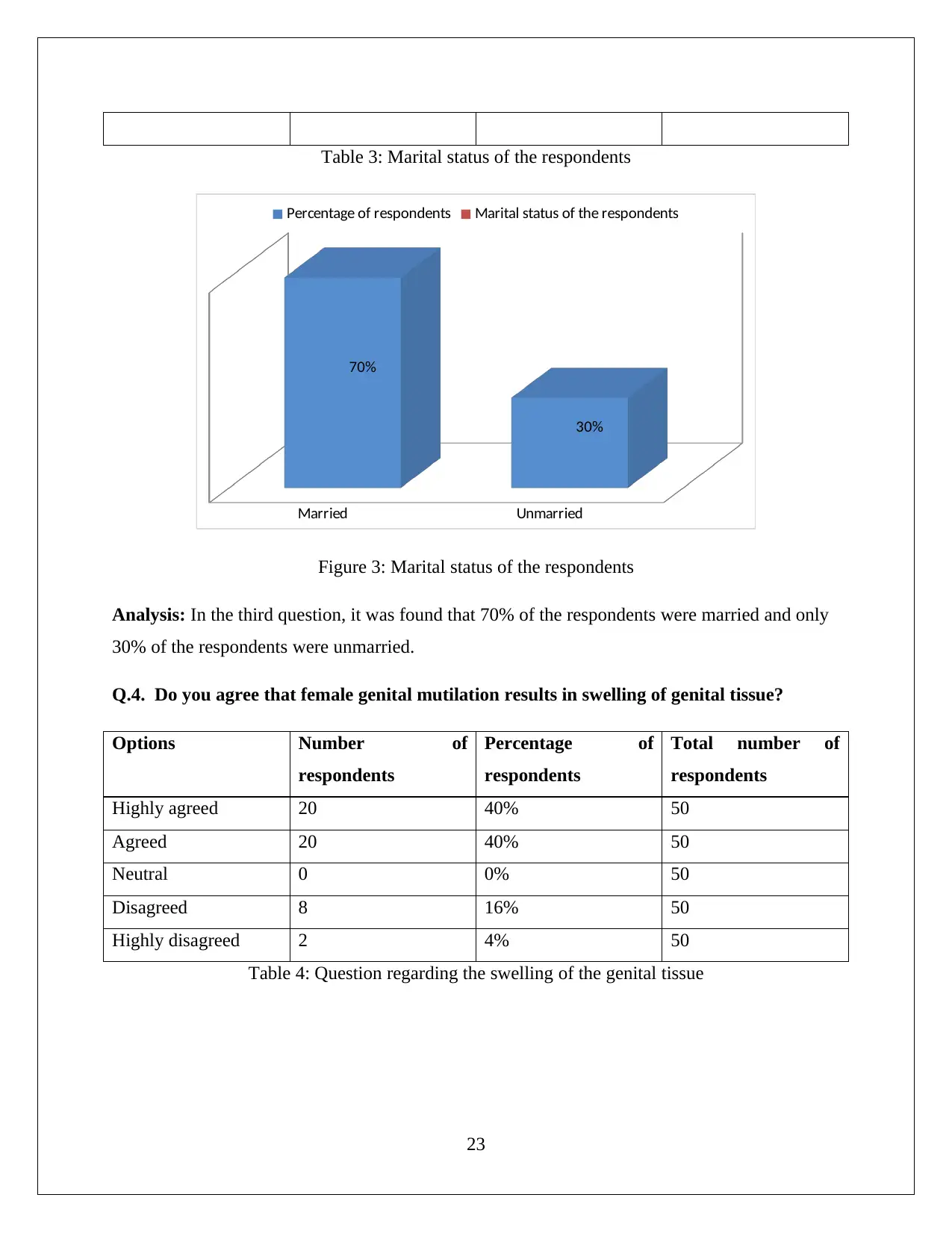
Table 3: Marital status of the respondents
Married Unmarried
70%
30%
Percentage of respondents Marital status of the respondents
Figure 3: Marital status of the respondents
Analysis: In the third question, it was found that 70% of the respondents were married and only
30% of the respondents were unmarried.
Q.4. Do you agree that female genital mutilation results in swelling of genital tissue?
Options Number of
respondents
Percentage of
respondents
Total number of
respondents
Highly agreed 20 40% 50
Agreed 20 40% 50
Neutral 0 0% 50
Disagreed 8 16% 50
Highly disagreed 2 4% 50
Table 4: Question regarding the swelling of the genital tissue
23
Married Unmarried
70%
30%
Percentage of respondents Marital status of the respondents
Figure 3: Marital status of the respondents
Analysis: In the third question, it was found that 70% of the respondents were married and only
30% of the respondents were unmarried.
Q.4. Do you agree that female genital mutilation results in swelling of genital tissue?
Options Number of
respondents
Percentage of
respondents
Total number of
respondents
Highly agreed 20 40% 50
Agreed 20 40% 50
Neutral 0 0% 50
Disagreed 8 16% 50
Highly disagreed 2 4% 50
Table 4: Question regarding the swelling of the genital tissue
23
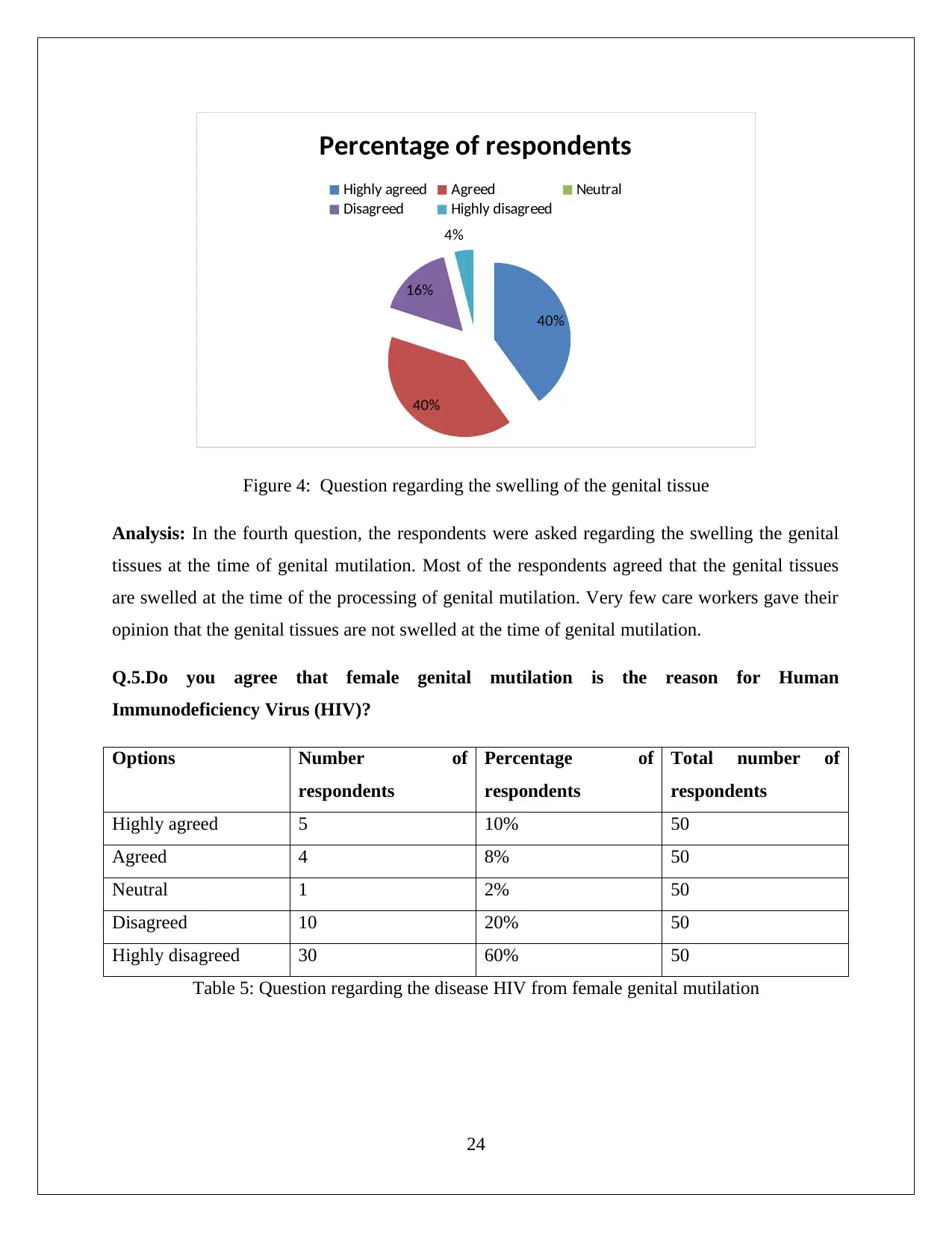
40%
40%
16%
4%
Percentage of respondents
Highly agreed Agreed Neutral
Disagreed Highly disagreed
Figure 4: Question regarding the swelling of the genital tissue
Analysis: In the fourth question, the respondents were asked regarding the swelling the genital
tissues at the time of genital mutilation. Most of the respondents agreed that the genital tissues
are swelled at the time of the processing of genital mutilation. Very few care workers gave their
opinion that the genital tissues are not swelled at the time of genital mutilation.
Q.5.Do you agree that female genital mutilation is the reason for Human
Immunodeficiency Virus (HIV)?
Options Number of
respondents
Percentage of
respondents
Total number of
respondents
Highly agreed 5 10% 50
Agreed 4 8% 50
Neutral 1 2% 50
Disagreed 10 20% 50
Highly disagreed 30 60% 50
Table 5: Question regarding the disease HIV from female genital mutilation
24
40%
16%
4%
Percentage of respondents
Highly agreed Agreed Neutral
Disagreed Highly disagreed
Figure 4: Question regarding the swelling of the genital tissue
Analysis: In the fourth question, the respondents were asked regarding the swelling the genital
tissues at the time of genital mutilation. Most of the respondents agreed that the genital tissues
are swelled at the time of the processing of genital mutilation. Very few care workers gave their
opinion that the genital tissues are not swelled at the time of genital mutilation.
Q.5.Do you agree that female genital mutilation is the reason for Human
Immunodeficiency Virus (HIV)?
Options Number of
respondents
Percentage of
respondents
Total number of
respondents
Highly agreed 5 10% 50
Agreed 4 8% 50
Neutral 1 2% 50
Disagreed 10 20% 50
Highly disagreed 30 60% 50
Table 5: Question regarding the disease HIV from female genital mutilation
24
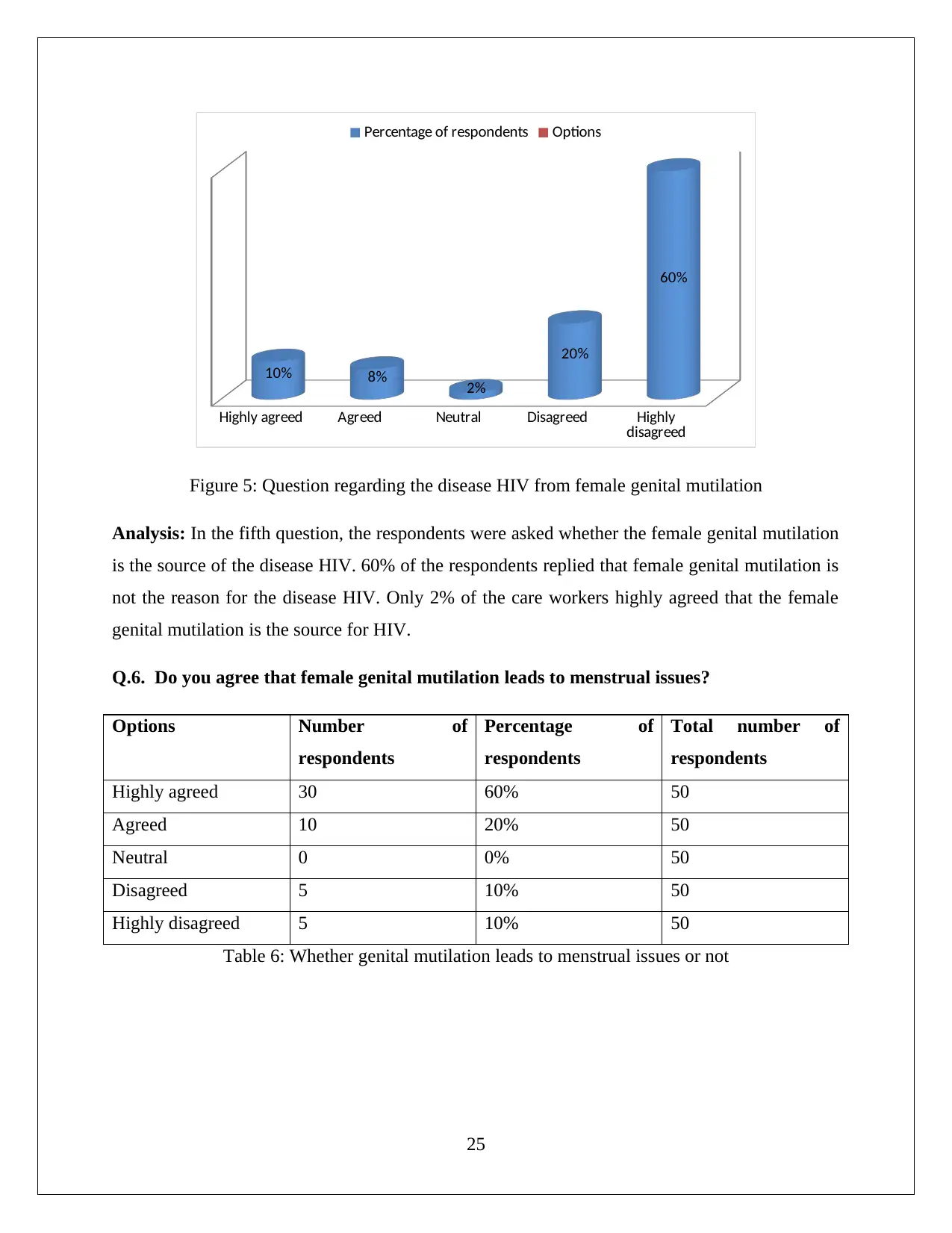
Highly agreed Agreed Neutral Disagreed Highly
disagreed
10% 8% 2%
20%
60%
Percentage of respondents Options
Figure 5: Question regarding the disease HIV from female genital mutilation
Analysis: In the fifth question, the respondents were asked whether the female genital mutilation
is the source of the disease HIV. 60% of the respondents replied that female genital mutilation is
not the reason for the disease HIV. Only 2% of the care workers highly agreed that the female
genital mutilation is the source for HIV.
Q.6. Do you agree that female genital mutilation leads to menstrual issues?
Options Number of
respondents
Percentage of
respondents
Total number of
respondents
Highly agreed 30 60% 50
Agreed 10 20% 50
Neutral 0 0% 50
Disagreed 5 10% 50
Highly disagreed 5 10% 50
Table 6: Whether genital mutilation leads to menstrual issues or not
25
disagreed
10% 8% 2%
20%
60%
Percentage of respondents Options
Figure 5: Question regarding the disease HIV from female genital mutilation
Analysis: In the fifth question, the respondents were asked whether the female genital mutilation
is the source of the disease HIV. 60% of the respondents replied that female genital mutilation is
not the reason for the disease HIV. Only 2% of the care workers highly agreed that the female
genital mutilation is the source for HIV.
Q.6. Do you agree that female genital mutilation leads to menstrual issues?
Options Number of
respondents
Percentage of
respondents
Total number of
respondents
Highly agreed 30 60% 50
Agreed 10 20% 50
Neutral 0 0% 50
Disagreed 5 10% 50
Highly disagreed 5 10% 50
Table 6: Whether genital mutilation leads to menstrual issues or not
25
Paraphrase This Document
Need a fresh take? Get an instant paraphrase of this document with our AI Paraphraser
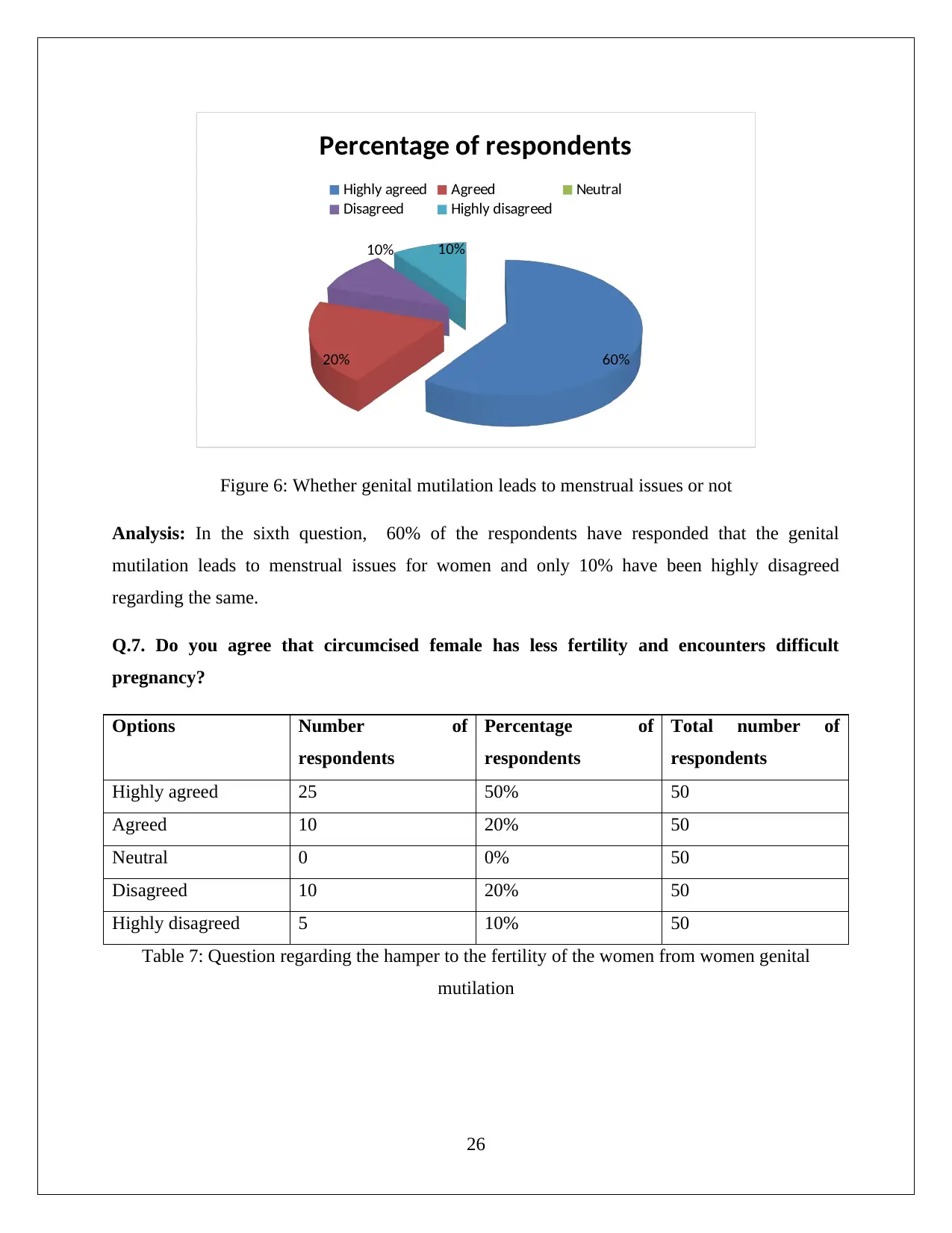
60%20%
10% 10%
Percentage of respondents
Highly agreed Agreed Neutral
Disagreed Highly disagreed
Figure 6: Whether genital mutilation leads to menstrual issues or not
Analysis: In the sixth question, 60% of the respondents have responded that the genital
mutilation leads to menstrual issues for women and only 10% have been highly disagreed
regarding the same.
Q.7. Do you agree that circumcised female has less fertility and encounters difficult
pregnancy?
Options Number of
respondents
Percentage of
respondents
Total number of
respondents
Highly agreed 25 50% 50
Agreed 10 20% 50
Neutral 0 0% 50
Disagreed 10 20% 50
Highly disagreed 5 10% 50
Table 7: Question regarding the hamper to the fertility of the women from women genital
mutilation
26
10% 10%
Percentage of respondents
Highly agreed Agreed Neutral
Disagreed Highly disagreed
Figure 6: Whether genital mutilation leads to menstrual issues or not
Analysis: In the sixth question, 60% of the respondents have responded that the genital
mutilation leads to menstrual issues for women and only 10% have been highly disagreed
regarding the same.
Q.7. Do you agree that circumcised female has less fertility and encounters difficult
pregnancy?
Options Number of
respondents
Percentage of
respondents
Total number of
respondents
Highly agreed 25 50% 50
Agreed 10 20% 50
Neutral 0 0% 50
Disagreed 10 20% 50
Highly disagreed 5 10% 50
Table 7: Question regarding the hamper to the fertility of the women from women genital
mutilation
26
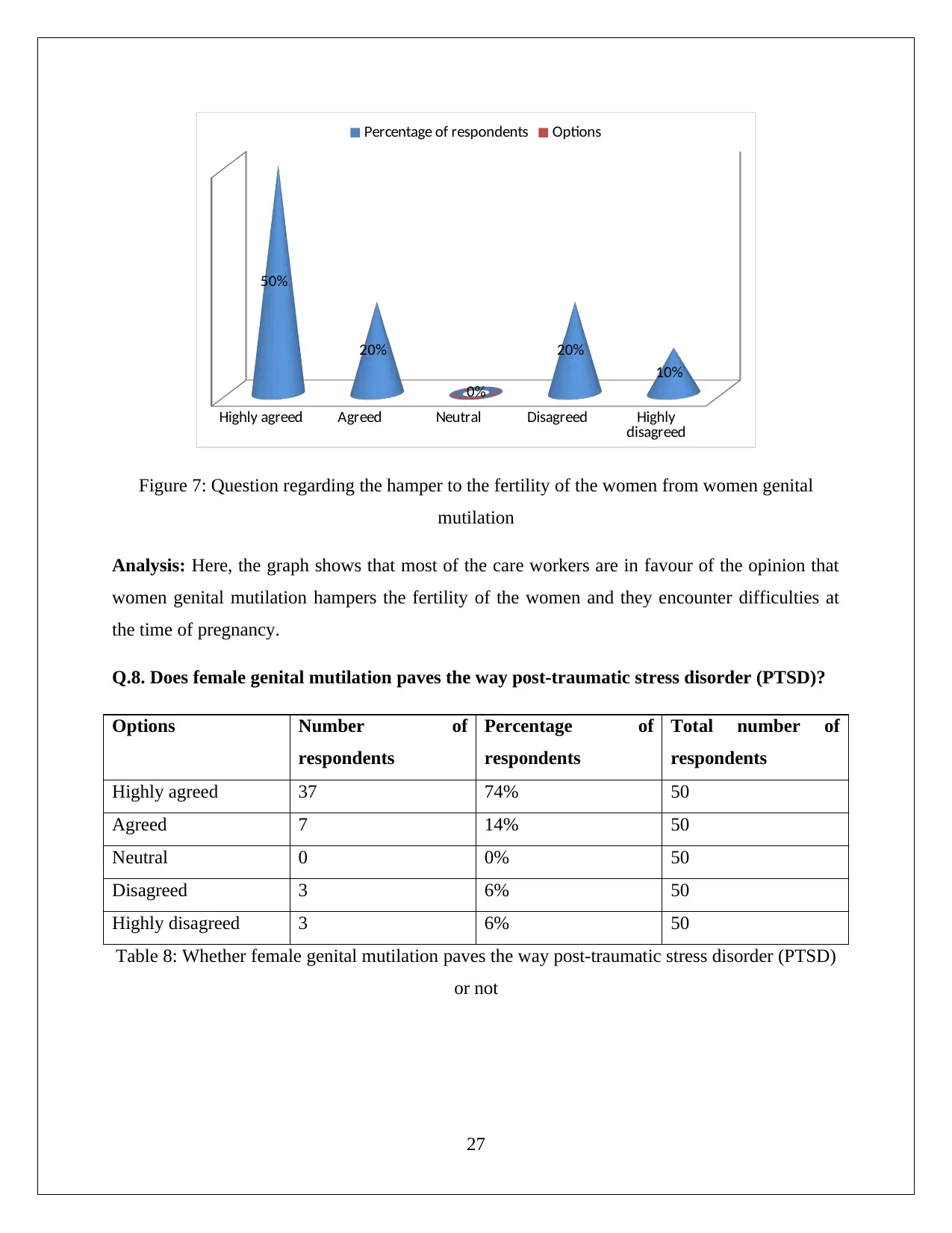
Highly agreed Agreed Neutral Disagreed Highly
disagreed
50%
20%
0%
20%
10%
Percentage of respondents Options
Figure 7: Question regarding the hamper to the fertility of the women from women genital
mutilation
Analysis: Here, the graph shows that most of the care workers are in favour of the opinion that
women genital mutilation hampers the fertility of the women and they encounter difficulties at
the time of pregnancy.
Q.8. Does female genital mutilation paves the way post-traumatic stress disorder (PTSD)?
Options Number of
respondents
Percentage of
respondents
Total number of
respondents
Highly agreed 37 74% 50
Agreed 7 14% 50
Neutral 0 0% 50
Disagreed 3 6% 50
Highly disagreed 3 6% 50
Table 8: Whether female genital mutilation paves the way post-traumatic stress disorder (PTSD)
or not
27
disagreed
50%
20%
0%
20%
10%
Percentage of respondents Options
Figure 7: Question regarding the hamper to the fertility of the women from women genital
mutilation
Analysis: Here, the graph shows that most of the care workers are in favour of the opinion that
women genital mutilation hampers the fertility of the women and they encounter difficulties at
the time of pregnancy.
Q.8. Does female genital mutilation paves the way post-traumatic stress disorder (PTSD)?
Options Number of
respondents
Percentage of
respondents
Total number of
respondents
Highly agreed 37 74% 50
Agreed 7 14% 50
Neutral 0 0% 50
Disagreed 3 6% 50
Highly disagreed 3 6% 50
Table 8: Whether female genital mutilation paves the way post-traumatic stress disorder (PTSD)
or not
27
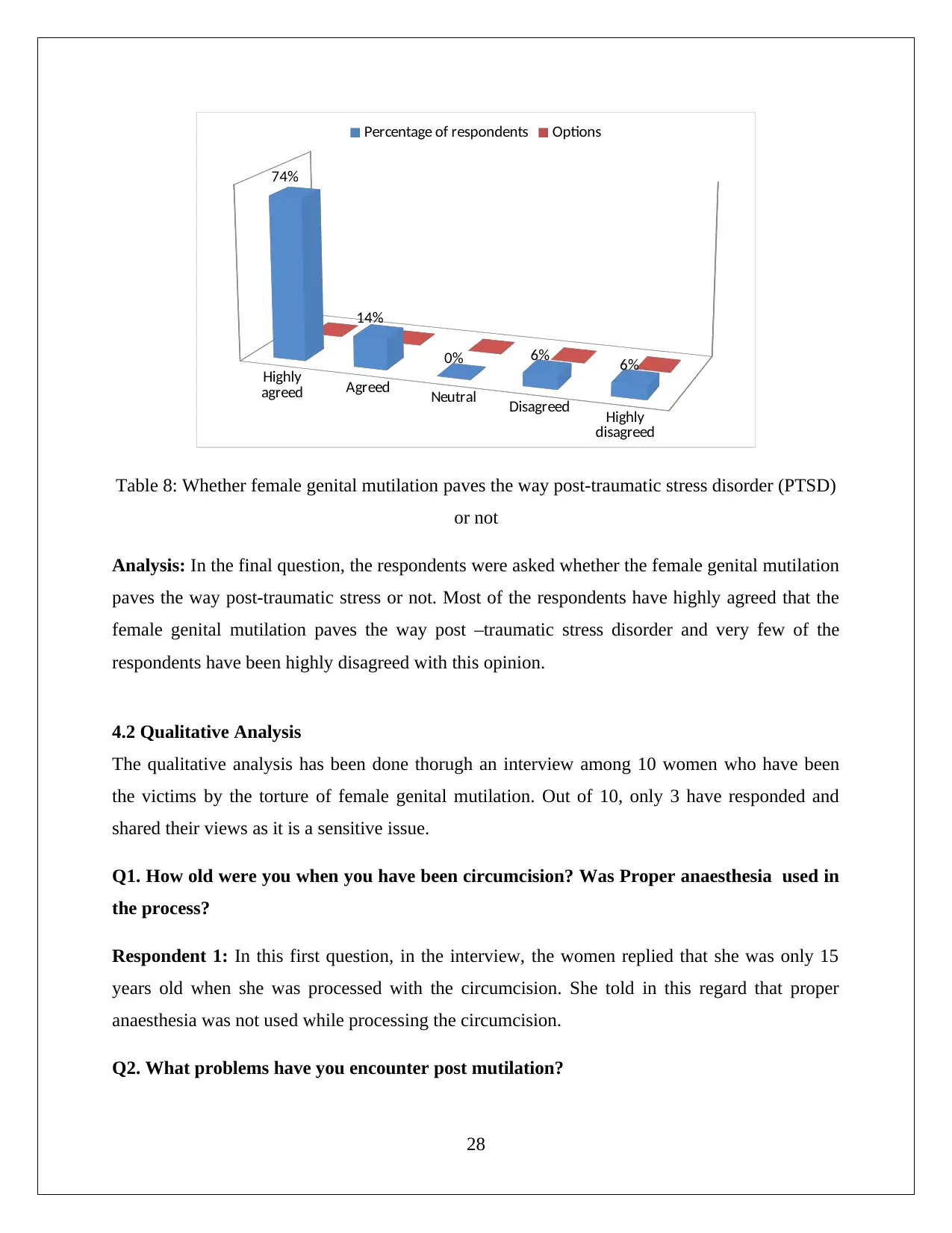
Highly
agreed Agreed Neutral Disagreed Highly
disagreed
74%
14%
0% 6% 6%
Percentage of respondents Options
Table 8: Whether female genital mutilation paves the way post-traumatic stress disorder (PTSD)
or not
Analysis: In the final question, the respondents were asked whether the female genital mutilation
paves the way post-traumatic stress or not. Most of the respondents have highly agreed that the
female genital mutilation paves the way post –traumatic stress disorder and very few of the
respondents have been highly disagreed with this opinion.
4.2 Qualitative Analysis
The qualitative analysis has been done thorugh an interview among 10 women who have been
the victims by the torture of female genital mutilation. Out of 10, only 3 have responded and
shared their views as it is a sensitive issue.
Q1. How old were you when you have been circumcision? Was Proper anaesthesia used in
the process?
Respondent 1: In this first question, in the interview, the women replied that she was only 15
years old when she was processed with the circumcision. She told in this regard that proper
anaesthesia was not used while processing the circumcision.
Q2. What problems have you encounter post mutilation?
28
agreed Agreed Neutral Disagreed Highly
disagreed
74%
14%
0% 6% 6%
Percentage of respondents Options
Table 8: Whether female genital mutilation paves the way post-traumatic stress disorder (PTSD)
or not
Analysis: In the final question, the respondents were asked whether the female genital mutilation
paves the way post-traumatic stress or not. Most of the respondents have highly agreed that the
female genital mutilation paves the way post –traumatic stress disorder and very few of the
respondents have been highly disagreed with this opinion.
4.2 Qualitative Analysis
The qualitative analysis has been done thorugh an interview among 10 women who have been
the victims by the torture of female genital mutilation. Out of 10, only 3 have responded and
shared their views as it is a sensitive issue.
Q1. How old were you when you have been circumcision? Was Proper anaesthesia used in
the process?
Respondent 1: In this first question, in the interview, the women replied that she was only 15
years old when she was processed with the circumcision. She told in this regard that proper
anaesthesia was not used while processing the circumcision.
Q2. What problems have you encounter post mutilation?
28
Secure Best Marks with AI Grader
Need help grading? Try our AI Grader for instant feedback on your assignments.
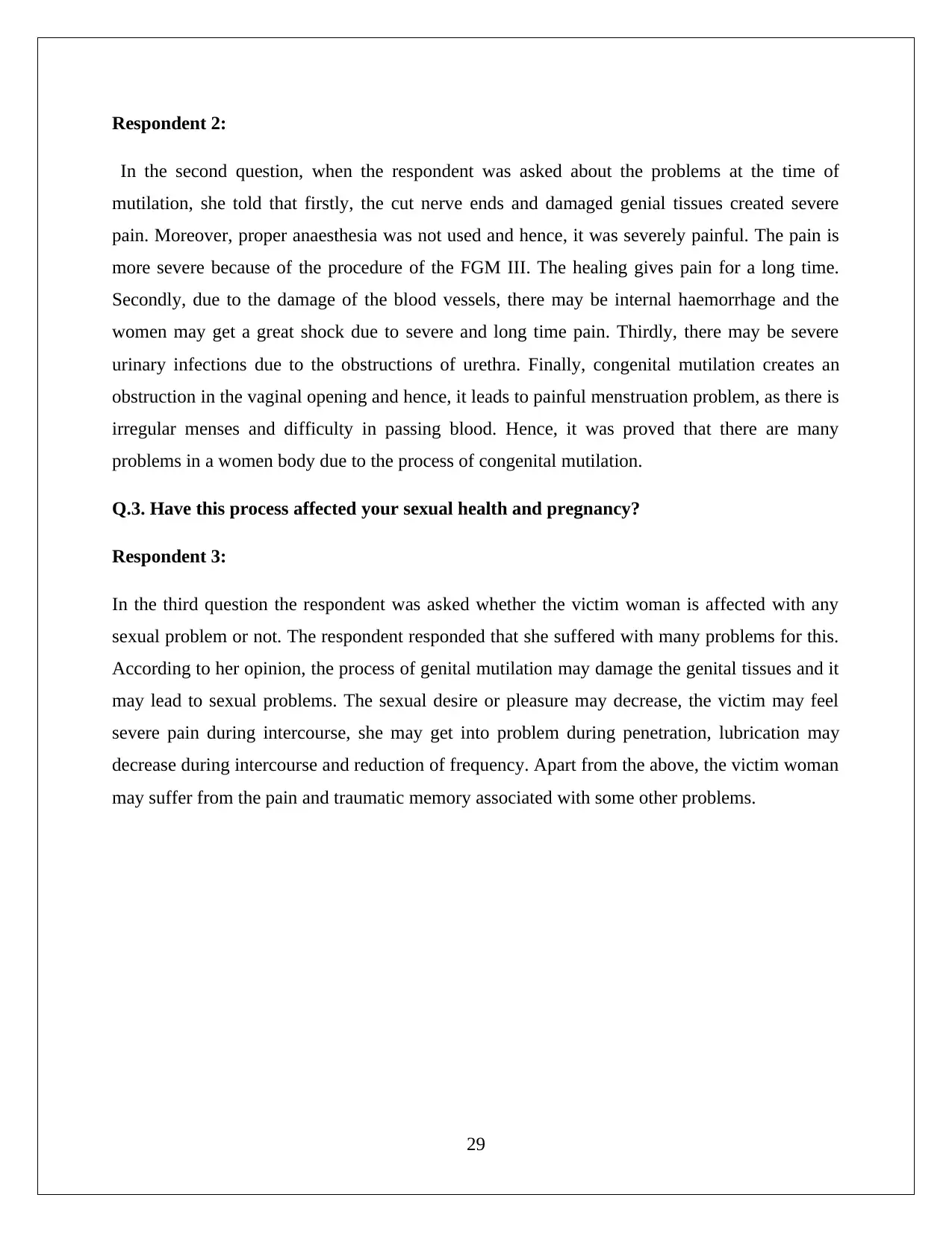
Respondent 2:
In the second question, when the respondent was asked about the problems at the time of
mutilation, she told that firstly, the cut nerve ends and damaged genial tissues created severe
pain. Moreover, proper anaesthesia was not used and hence, it was severely painful. The pain is
more severe because of the procedure of the FGM III. The healing gives pain for a long time.
Secondly, due to the damage of the blood vessels, there may be internal haemorrhage and the
women may get a great shock due to severe and long time pain. Thirdly, there may be severe
urinary infections due to the obstructions of urethra. Finally, congenital mutilation creates an
obstruction in the vaginal opening and hence, it leads to painful menstruation problem, as there is
irregular menses and difficulty in passing blood. Hence, it was proved that there are many
problems in a women body due to the process of congenital mutilation.
Q.3. Have this process affected your sexual health and pregnancy?
Respondent 3:
In the third question the respondent was asked whether the victim woman is affected with any
sexual problem or not. The respondent responded that she suffered with many problems for this.
According to her opinion, the process of genital mutilation may damage the genital tissues and it
may lead to sexual problems. The sexual desire or pleasure may decrease, the victim may feel
severe pain during intercourse, she may get into problem during penetration, lubrication may
decrease during intercourse and reduction of frequency. Apart from the above, the victim woman
may suffer from the pain and traumatic memory associated with some other problems.
29
In the second question, when the respondent was asked about the problems at the time of
mutilation, she told that firstly, the cut nerve ends and damaged genial tissues created severe
pain. Moreover, proper anaesthesia was not used and hence, it was severely painful. The pain is
more severe because of the procedure of the FGM III. The healing gives pain for a long time.
Secondly, due to the damage of the blood vessels, there may be internal haemorrhage and the
women may get a great shock due to severe and long time pain. Thirdly, there may be severe
urinary infections due to the obstructions of urethra. Finally, congenital mutilation creates an
obstruction in the vaginal opening and hence, it leads to painful menstruation problem, as there is
irregular menses and difficulty in passing blood. Hence, it was proved that there are many
problems in a women body due to the process of congenital mutilation.
Q.3. Have this process affected your sexual health and pregnancy?
Respondent 3:
In the third question the respondent was asked whether the victim woman is affected with any
sexual problem or not. The respondent responded that she suffered with many problems for this.
According to her opinion, the process of genital mutilation may damage the genital tissues and it
may lead to sexual problems. The sexual desire or pleasure may decrease, the victim may feel
severe pain during intercourse, she may get into problem during penetration, lubrication may
decrease during intercourse and reduction of frequency. Apart from the above, the victim woman
may suffer from the pain and traumatic memory associated with some other problems.
29

Chapter 5: Conclusion and Recommendations
5.1 Linking with Objectives
To explore the culture and religious justification of the practice: Through the questions
asked to the respondents in the survey, the answers will explore the culture and fetch a religious
justification of such evil practice all over the world.
To evaluate the effect on women’s health during marriage and childbirth: The interview
questions and the analysis of those questions have helped to evaluate women’s health during
marriage and childbirth. That analysis will help the researcher and other learner to understand the
problem and reform the social evil practices.
To provide the current situation regarding the practice of female genital mutilation in
Britain: This research work and the survey and interview methods have been conducted in the
United Kingdom and hence, this research will help enough to reform such practices in Britain.
The entire women section of Britain will be benefitted by this research.
To safeguard and protect the mal practice of FMG with the help of the Government of
United Kingdom’s in UK: The data and information collected in the literature review and in
primary survey from the respondents will help the government of the UK to understand the
actual problems due to the malpractice of female genital mutilation. The malpractice will be
eradicated from the country.
5.2 Recommendations
The governments of those countries in which the women are the victims with this practice
should take some stern and rigid steps to band this type of practice. In case of the
violation of the rules, people should be punished.
Women in those effective countries should be educated and made aware of the evil
effects of this practice. Frequent campaigns should be held in those countries for this
purpose.
30
5.1 Linking with Objectives
To explore the culture and religious justification of the practice: Through the questions
asked to the respondents in the survey, the answers will explore the culture and fetch a religious
justification of such evil practice all over the world.
To evaluate the effect on women’s health during marriage and childbirth: The interview
questions and the analysis of those questions have helped to evaluate women’s health during
marriage and childbirth. That analysis will help the researcher and other learner to understand the
problem and reform the social evil practices.
To provide the current situation regarding the practice of female genital mutilation in
Britain: This research work and the survey and interview methods have been conducted in the
United Kingdom and hence, this research will help enough to reform such practices in Britain.
The entire women section of Britain will be benefitted by this research.
To safeguard and protect the mal practice of FMG with the help of the Government of
United Kingdom’s in UK: The data and information collected in the literature review and in
primary survey from the respondents will help the government of the UK to understand the
actual problems due to the malpractice of female genital mutilation. The malpractice will be
eradicated from the country.
5.2 Recommendations
The governments of those countries in which the women are the victims with this practice
should take some stern and rigid steps to band this type of practice. In case of the
violation of the rules, people should be punished.
Women in those effective countries should be educated and made aware of the evil
effects of this practice. Frequent campaigns should be held in those countries for this
purpose.
30
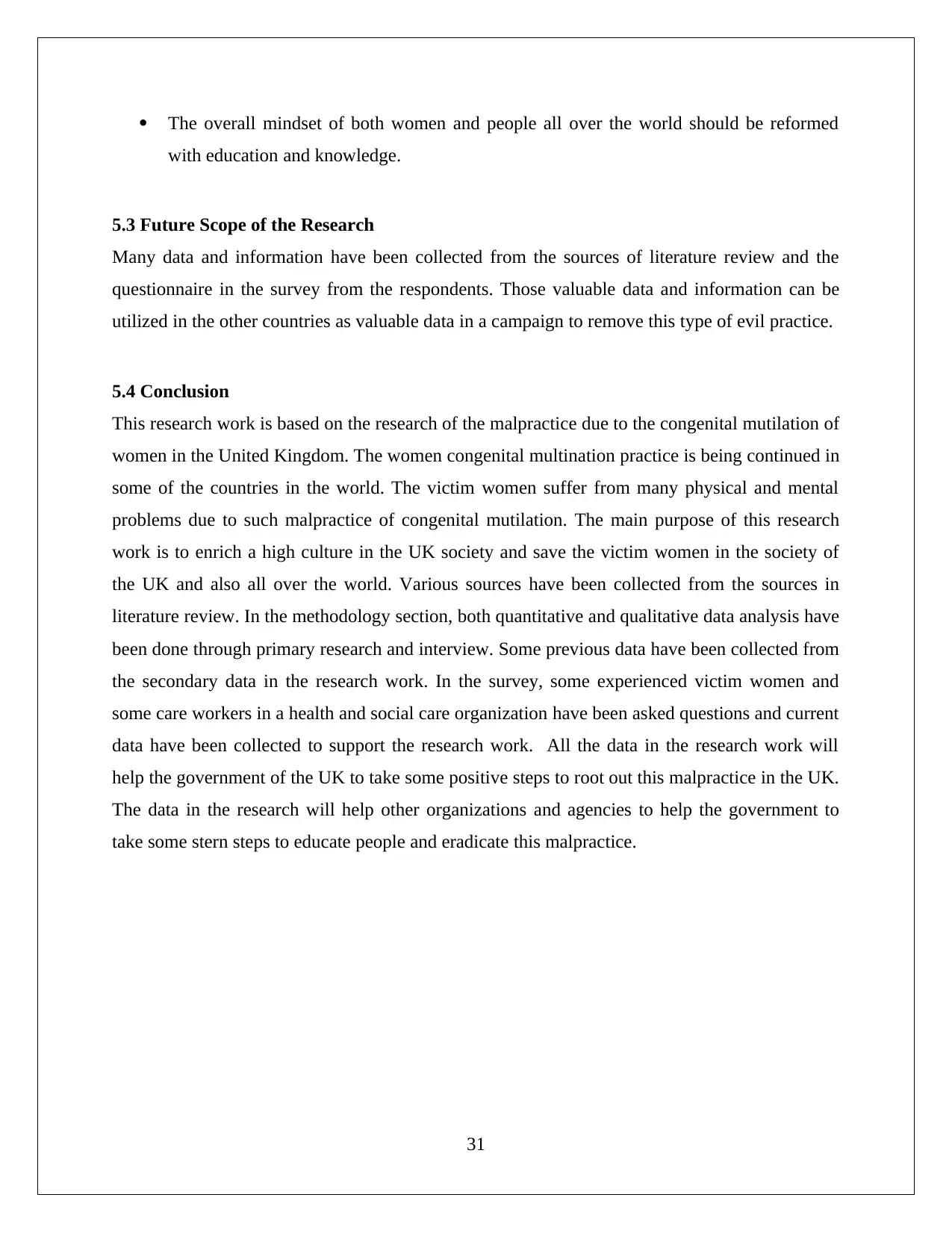
The overall mindset of both women and people all over the world should be reformed
with education and knowledge.
5.3 Future Scope of the Research
Many data and information have been collected from the sources of literature review and the
questionnaire in the survey from the respondents. Those valuable data and information can be
utilized in the other countries as valuable data in a campaign to remove this type of evil practice.
5.4 Conclusion
This research work is based on the research of the malpractice due to the congenital mutilation of
women in the United Kingdom. The women congenital multination practice is being continued in
some of the countries in the world. The victim women suffer from many physical and mental
problems due to such malpractice of congenital mutilation. The main purpose of this research
work is to enrich a high culture in the UK society and save the victim women in the society of
the UK and also all over the world. Various sources have been collected from the sources in
literature review. In the methodology section, both quantitative and qualitative data analysis have
been done through primary research and interview. Some previous data have been collected from
the secondary data in the research work. In the survey, some experienced victim women and
some care workers in a health and social care organization have been asked questions and current
data have been collected to support the research work. All the data in the research work will
help the government of the UK to take some positive steps to root out this malpractice in the UK.
The data in the research will help other organizations and agencies to help the government to
take some stern steps to educate people and eradicate this malpractice.
31
with education and knowledge.
5.3 Future Scope of the Research
Many data and information have been collected from the sources of literature review and the
questionnaire in the survey from the respondents. Those valuable data and information can be
utilized in the other countries as valuable data in a campaign to remove this type of evil practice.
5.4 Conclusion
This research work is based on the research of the malpractice due to the congenital mutilation of
women in the United Kingdom. The women congenital multination practice is being continued in
some of the countries in the world. The victim women suffer from many physical and mental
problems due to such malpractice of congenital mutilation. The main purpose of this research
work is to enrich a high culture in the UK society and save the victim women in the society of
the UK and also all over the world. Various sources have been collected from the sources in
literature review. In the methodology section, both quantitative and qualitative data analysis have
been done through primary research and interview. Some previous data have been collected from
the secondary data in the research work. In the survey, some experienced victim women and
some care workers in a health and social care organization have been asked questions and current
data have been collected to support the research work. All the data in the research work will
help the government of the UK to take some positive steps to root out this malpractice in the UK.
The data in the research will help other organizations and agencies to help the government to
take some stern steps to educate people and eradicate this malpractice.
31
Paraphrase This Document
Need a fresh take? Get an instant paraphrase of this document with our AI Paraphraser
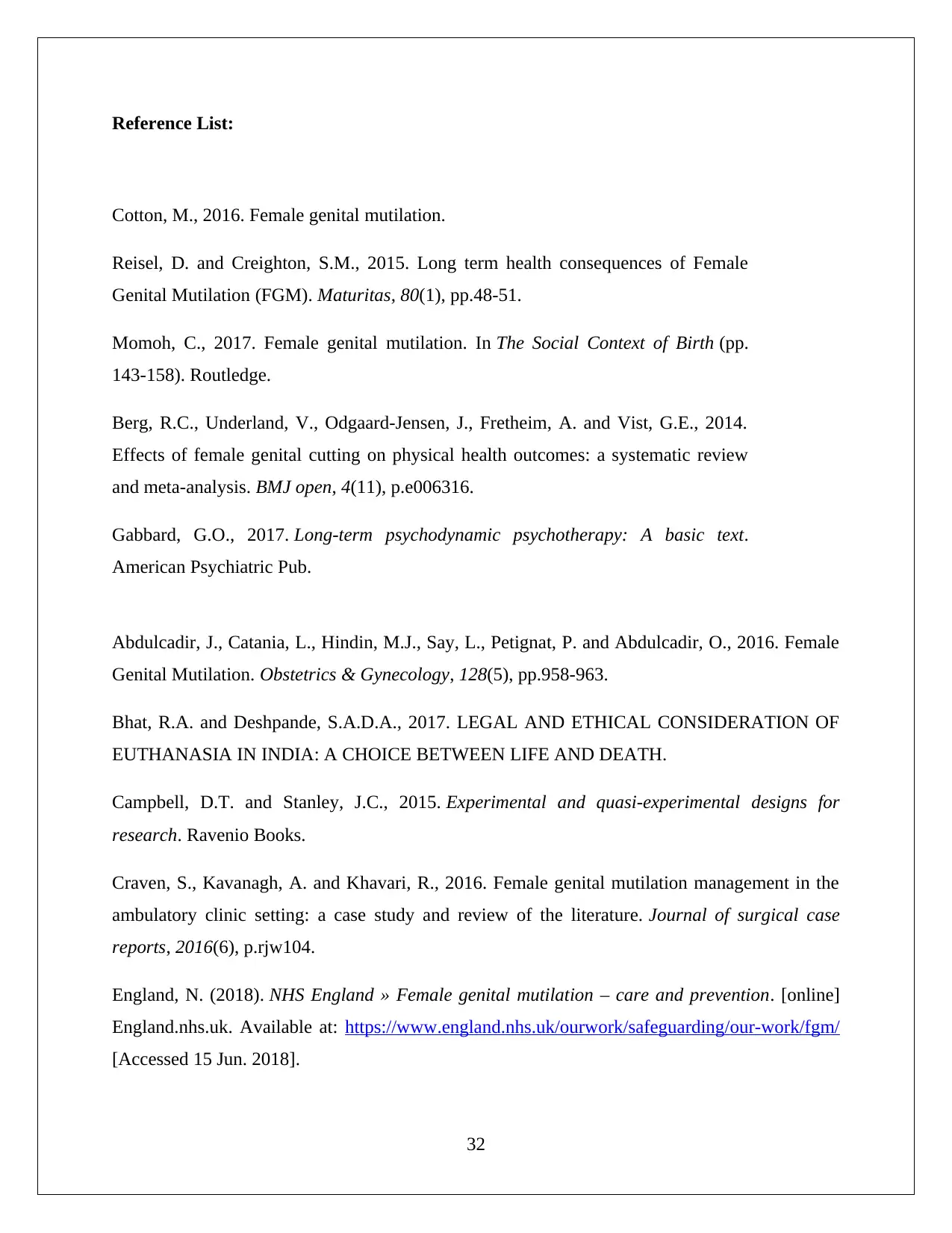
Reference List:
Cotton, M., 2016. Female genital mutilation.
Reisel, D. and Creighton, S.M., 2015. Long term health consequences of Female
Genital Mutilation (FGM). Maturitas, 80(1), pp.48-51.
Momoh, C., 2017. Female genital mutilation. In The Social Context of Birth (pp.
143-158). Routledge.
Berg, R.C., Underland, V., Odgaard-Jensen, J., Fretheim, A. and Vist, G.E., 2014.
Effects of female genital cutting on physical health outcomes: a systematic review
and meta-analysis. BMJ open, 4(11), p.e006316.
Gabbard, G.O., 2017. Long-term psychodynamic psychotherapy: A basic text.
American Psychiatric Pub.
Abdulcadir, J., Catania, L., Hindin, M.J., Say, L., Petignat, P. and Abdulcadir, O., 2016. Female
Genital Mutilation. Obstetrics & Gynecology, 128(5), pp.958-963.
Bhat, R.A. and Deshpande, S.A.D.A., 2017. LEGAL AND ETHICAL CONSIDERATION OF
EUTHANASIA IN INDIA: A CHOICE BETWEEN LIFE AND DEATH.
Campbell, D.T. and Stanley, J.C., 2015. Experimental and quasi-experimental designs for
research. Ravenio Books.
Craven, S., Kavanagh, A. and Khavari, R., 2016. Female genital mutilation management in the
ambulatory clinic setting: a case study and review of the literature. Journal of surgical case
reports, 2016(6), p.rjw104.
England, N. (2018). NHS England » Female genital mutilation – care and prevention. [online]
England.nhs.uk. Available at: https://www.england.nhs.uk/ourwork/safeguarding/our-work/fgm/
[Accessed 15 Jun. 2018].
32
Cotton, M., 2016. Female genital mutilation.
Reisel, D. and Creighton, S.M., 2015. Long term health consequences of Female
Genital Mutilation (FGM). Maturitas, 80(1), pp.48-51.
Momoh, C., 2017. Female genital mutilation. In The Social Context of Birth (pp.
143-158). Routledge.
Berg, R.C., Underland, V., Odgaard-Jensen, J., Fretheim, A. and Vist, G.E., 2014.
Effects of female genital cutting on physical health outcomes: a systematic review
and meta-analysis. BMJ open, 4(11), p.e006316.
Gabbard, G.O., 2017. Long-term psychodynamic psychotherapy: A basic text.
American Psychiatric Pub.
Abdulcadir, J., Catania, L., Hindin, M.J., Say, L., Petignat, P. and Abdulcadir, O., 2016. Female
Genital Mutilation. Obstetrics & Gynecology, 128(5), pp.958-963.
Bhat, R.A. and Deshpande, S.A.D.A., 2017. LEGAL AND ETHICAL CONSIDERATION OF
EUTHANASIA IN INDIA: A CHOICE BETWEEN LIFE AND DEATH.
Campbell, D.T. and Stanley, J.C., 2015. Experimental and quasi-experimental designs for
research. Ravenio Books.
Craven, S., Kavanagh, A. and Khavari, R., 2016. Female genital mutilation management in the
ambulatory clinic setting: a case study and review of the literature. Journal of surgical case
reports, 2016(6), p.rjw104.
England, N. (2018). NHS England » Female genital mutilation – care and prevention. [online]
England.nhs.uk. Available at: https://www.england.nhs.uk/ourwork/safeguarding/our-work/fgm/
[Accessed 15 Jun. 2018].
32
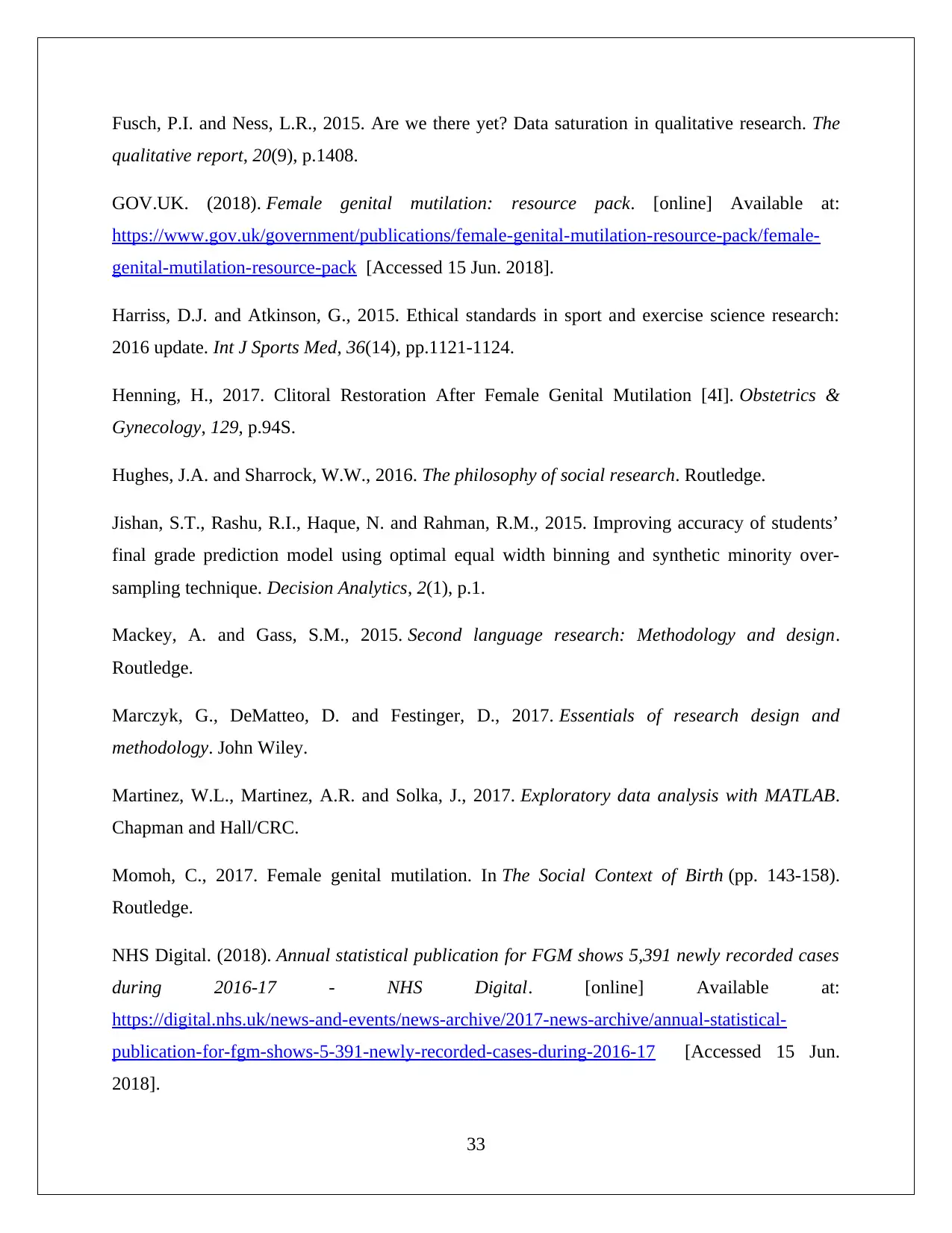
Fusch, P.I. and Ness, L.R., 2015. Are we there yet? Data saturation in qualitative research. The
qualitative report, 20(9), p.1408.
GOV.UK. (2018). Female genital mutilation: resource pack. [online] Available at:
https://www.gov.uk/government/publications/female-genital-mutilation-resource-pack/female-
genital-mutilation-resource-pack [Accessed 15 Jun. 2018].
Harriss, D.J. and Atkinson, G., 2015. Ethical standards in sport and exercise science research:
2016 update. Int J Sports Med, 36(14), pp.1121-1124.
Henning, H., 2017. Clitoral Restoration After Female Genital Mutilation [4I]. Obstetrics &
Gynecology, 129, p.94S.
Hughes, J.A. and Sharrock, W.W., 2016. The philosophy of social research. Routledge.
Jishan, S.T., Rashu, R.I., Haque, N. and Rahman, R.M., 2015. Improving accuracy of students’
final grade prediction model using optimal equal width binning and synthetic minority over-
sampling technique. Decision Analytics, 2(1), p.1.
Mackey, A. and Gass, S.M., 2015. Second language research: Methodology and design.
Routledge.
Marczyk, G., DeMatteo, D. and Festinger, D., 2017. Essentials of research design and
methodology. John Wiley.
Martinez, W.L., Martinez, A.R. and Solka, J., 2017. Exploratory data analysis with MATLAB.
Chapman and Hall/CRC.
Momoh, C., 2017. Female genital mutilation. In The Social Context of Birth (pp. 143-158).
Routledge.
NHS Digital. (2018). Annual statistical publication for FGM shows 5,391 newly recorded cases
during 2016-17 - NHS Digital. [online] Available at:
https://digital.nhs.uk/news-and-events/news-archive/2017-news-archive/annual-statistical-
publication-for-fgm-shows-5-391-newly-recorded-cases-during-2016-17 [Accessed 15 Jun.
2018].
33
qualitative report, 20(9), p.1408.
GOV.UK. (2018). Female genital mutilation: resource pack. [online] Available at:
https://www.gov.uk/government/publications/female-genital-mutilation-resource-pack/female-
genital-mutilation-resource-pack [Accessed 15 Jun. 2018].
Harriss, D.J. and Atkinson, G., 2015. Ethical standards in sport and exercise science research:
2016 update. Int J Sports Med, 36(14), pp.1121-1124.
Henning, H., 2017. Clitoral Restoration After Female Genital Mutilation [4I]. Obstetrics &
Gynecology, 129, p.94S.
Hughes, J.A. and Sharrock, W.W., 2016. The philosophy of social research. Routledge.
Jishan, S.T., Rashu, R.I., Haque, N. and Rahman, R.M., 2015. Improving accuracy of students’
final grade prediction model using optimal equal width binning and synthetic minority over-
sampling technique. Decision Analytics, 2(1), p.1.
Mackey, A. and Gass, S.M., 2015. Second language research: Methodology and design.
Routledge.
Marczyk, G., DeMatteo, D. and Festinger, D., 2017. Essentials of research design and
methodology. John Wiley.
Martinez, W.L., Martinez, A.R. and Solka, J., 2017. Exploratory data analysis with MATLAB.
Chapman and Hall/CRC.
Momoh, C., 2017. Female genital mutilation. In The Social Context of Birth (pp. 143-158).
Routledge.
NHS Digital. (2018). Annual statistical publication for FGM shows 5,391 newly recorded cases
during 2016-17 - NHS Digital. [online] Available at:
https://digital.nhs.uk/news-and-events/news-archive/2017-news-archive/annual-statistical-
publication-for-fgm-shows-5-391-newly-recorded-cases-during-2016-17 [Accessed 15 Jun.
2018].
33

nhs.uk. (2018). Female genital mutilation (FGM). [online] Available at:
https://www.nhs.uk/conditions/female-genital-mutilation-fgm/ [Accessed 15 Jun. 2018].
O’Donnell, N.A., Leoni, M., Debelle, G., Lynn, R., Armitage, A., Creighton, S.M., Viner, R. and
Hodes, D., 2018. G142 Female genital mutilation surveillance in under 16 years olds in the uk
and ireland.
Sekaran, U. and Bougie, R., 2016. Research methods for business: A skill building approach.
John Wiley & Sons.
Vuong, Q.H., 2016. Data on Vietnamese patients' behavior in using information sources,
perceived data sufficiency and (non) optimal choice of healthcare provider.
Wang, J., LEADOT INNOVATION Inc, 2017. Three dimensional outline information sensing
system and sensing method. U.S. Patent Application 15/297,116.
34
https://www.nhs.uk/conditions/female-genital-mutilation-fgm/ [Accessed 15 Jun. 2018].
O’Donnell, N.A., Leoni, M., Debelle, G., Lynn, R., Armitage, A., Creighton, S.M., Viner, R. and
Hodes, D., 2018. G142 Female genital mutilation surveillance in under 16 years olds in the uk
and ireland.
Sekaran, U. and Bougie, R., 2016. Research methods for business: A skill building approach.
John Wiley & Sons.
Vuong, Q.H., 2016. Data on Vietnamese patients' behavior in using information sources,
perceived data sufficiency and (non) optimal choice of healthcare provider.
Wang, J., LEADOT INNOVATION Inc, 2017. Three dimensional outline information sensing
system and sensing method. U.S. Patent Application 15/297,116.
34
1 out of 34
Related Documents
Your All-in-One AI-Powered Toolkit for Academic Success.
+13062052269
info@desklib.com
Available 24*7 on WhatsApp / Email
![[object Object]](/_next/static/media/star-bottom.7253800d.svg)
Unlock your academic potential
© 2024 | Zucol Services PVT LTD | All rights reserved.





